 Hastings District
Council
Hastings District
Council
Civic Administration Building
Lyndon Road East, Hastings
Phone: (06) 871
5000
Fax:
(06) 871 5100
WWW.hastingsdc.govt.nz
Open
A G E N D A
Council MEETING
|
Meeting Date:
|
Thursday,
11 July 2019
|
|
10.30am
|
Waipatu Marae
Karamu Road
Hastings
|
|
1.30pm
|
Council
Chamber
Ground Floor
Civic
Administration Building
Lyndon Road
East
Hastings
|
|
Council Members
|
Chair: Mayor Hazlehurst
Councillors Barber, Dixon, Harvey, Heaps,
Kerr, Lawson, Lyons, Nixon, O’Keefe, Poulain, Redstone, Schollum,
Travers and Watkins
|
|
Officer
Responsible
|
Chief Executive – Mr N Bickle
|
|
Council
Secretary
|
Mrs C Hunt (Extn 5634)
|
HASTINGS DISTRICT COUNCIL
COUNCIL MEETING
Thursday, 11 July 2019
|
10.30am
|
Waipatu Marae
Karamu Road
Hastings
|
|
1.30pm
|
Council Chamber
Ground Floor
Civic Administration Building
Lyndon Road East
Hastings
|
|
A G E N D A
|
10.30AM - WAIPATU MARAE
1. 10.30am Mihi Whakatau
11.00am Waipatu Marae Community
Plan powerpoint presentation from Waipatu community plan leaders
11.30am Walk-around
Waipatu area
1.15pm Depart
Waipatu Marae for reconvened meeting in Council Chamber
2. Apologies
& Leave of Absence
At the close of the agenda no
apologies had been received.
Leave of Absences had previously
been granted to Councillor Lyons and Councillor Travers
3. Seal
Register
4. Conflict
of Interest
Members need to be vigilant to stand
aside from decision-making when a conflict arises between their role as a
Member of the Council and any private or other external interest they might
have. This note is provided as a reminder to Members to scan the agenda
and assess their own private interests and identify where they may have a
pecuniary or other conflict of interest, or where there may be perceptions of
conflict of interest.
If a Member feels they do
have a conflict of interest, they should publicly declare that at the start of
the relevant item of business and withdraw from participating in the
meeting. If a Member thinks they may have a conflict of interest,
they can seek advice from the General Counsel or the Democratic Support Manager
(preferably before the meeting).
It is noted that while Members can
seek advice and discuss these matters, the final decision as to whether a conflict
exists rests with the member.
5. Confirmation
of Minutes
Minutes of the
Council Meeting held Thursday 27 June 2019.
(Previously circulated)
6. Waipatu Community
Plan 2016-2021 5
1.30PM - COUNCIL
CHAMBER (Reconvene Meeting)
7. Presentation by
Hawke's Bay Cancer Society 21
8. Resolution to set
the Rates for the 2019/20 Financial Year 23
9. Hastings District
and Napier City Council’s joint Local Alcohol Policy (the LAP) 33
10. Toi-Tū Hawke's Bay
Strategic Framework 63
11. Hastings District Council
Drinking Water Quality Management Policy 69
12. Notification of Appointment of
Independent Hearings Commissioner 79
13. Requests Received under the
Local Government Official Information and Meetings Act (LGOIMA) Monthly Update 81
14. Clifton to Tangoio Coastal
Hazards Strategy Joint Committee Minutes 85
15. Additional
Business Items
16. Extraordinary
Business Items
17. Recommendation
to Exclude the Public from Item 18 95
18. Hawke's Bay Museum Trust
Regional Collection
REPORT TO: Council
MEETING DATE: Thursday 11
July 2019
FROM: Team Leader Community & Safety
Louise
Stettner
SUBJECT: Waipatu
Community Plan 2016-2021
1.0 SUMMARY
1.1 This report contributes to the achievement of the Council’s
community outcomes and specific Council objectives as set out in the Long Term
Plan 2018-28 by:
· putting people at the centre of planning and service.
1.2 The Council is required to give effect to the purpose of local
government as set out in section 10 of the Local Government Act 2002. That
purpose is to meet the current and future needs of communities for good quality
local infrastructure, local public services, and performance of regulatory
functions in a way that is most cost effective and appropriate to present and
anticipated future circumstances.
1.3 This
report concludes by recommending that Council endorse the Waipatu Community
Plan 2016-2021 (Aattachment 1), noting that actions within the plan
requiring new council funding will be requested through the appropriate processes.
Other funding opportunities will also be identified.
1.4 Representatives
from the Waipatu community will be presenting the plan to Council at Waipatu
Marae.
2.0 BACKGROUND
2.1 Hastings
District Council began developing community plans in 2002 as a means for
Council to engage with and provide additional support to communities deemed as
having high needs.
2.2 This
community plan builds on work done between 2016-2019 to address the
community’s desire to make Waipatu a safer place to live, and for community
members to be included in local developments.
2.3 Council
commissioned this plan in response to a submission to the 2018/19 Annual Plan
from Ngahiwi Tomoana on behalf of the community, asking the Council to address
the following concerns: water; footpaths; traffic and use of surplus land.
2.4 Because
of its proximity to Hastings and its rural sprawl the term “Ruban”
has been coined to reflect the rural and urban features of the area.
2.5 Waipatu
is historically and culturally significant. The first formal session of Te
Kotahitanga (Maori Parliament) was held in June 1892 at Waipatu. Other
significant historical and cultural features include the church, urupa and
Treaty of Waitangi memorial.
2.6 The
plan was developed through community engagement hui (meetings) held at Waipatu
Marae between October and December 2018 with a final community meeting held at
the end of April 2019. Council representatives, government agency
representatives and other stakeholders and partners participated to discuss a
range of community priorities.
3.0 CURRENT
SITUATION
3.1 The
Waipatu Community Plan 2016 – 2021 has been completed and is attached.
The earlier date of 2016 reflects that this work has been informed by
discussions with the community since 2016.
3.2 The long-term
vision is “We are one – a connected community, building on our past
to create our prosperous future”.
3.3 The
priority areas identified in the plan include:
· identity and culture;
· water;
· traffic and safety; and
· development.
3.4 The
plan includes a list of actions to address the priority areas. The
Waipatu community will be supported by a Council officer to drive the
implementation of the plan and monitor progress.
3.5 Representatives
from the Waipatu community will be presenting the plan to Council at Waipatu
Marae.
3.6 Councillors
will be aware of the recent announcement in respect of Provincial Growth Fund
support to develop an Eastside Masterplan. The Waipatu community plan
will form a useful input into that wider planning study given that it is
located within the planning study area.
4.0 OPTIONS
4.1 The
Council endorses the Waipatu Community Plan, noting that the actions within the
plan requiring new Council funding will be requested through the appropriate
Council processes.
4.2 Council
does not endorse the Waipatu Community Plan.
5.0 SIGNIFICANCE
AND ENGAGEMENT
5.1 The
consultation process was led by a community leadership team that arranged
community meetings promoted through Facebook, e-mail and letter box drops.
5.2 This
report does not trigger the Council’s significance policy. No
further consultation is required for the decisions in this report.
6.0 ASSESSMENT
OF OPTIONS (INCLUDING FINANCIAL IMPLICATIONS)
6.1 Council
endorsement of the Waipatu Community Plan 2016-2021 would signal support at a
high level for the collaborative approach being taken to the delivery of
actions within this community.
6.2 Endorsement
does not commit Council to allocate funds or other resources to any or all of
the actions or ideas noted in the plan, as this will be done in an integrated
way through Council’s Long Term Plan and Annual Plan processes.
6.3 Other
funding opportunities will also be investigated.
6.4 A
decision not to endorse the Waipatu Community Plan 2016-2021 could harm
relationships with the Waipatu community who have led a robust consultation and
plan development process.
7.0 PREFERRED
OPTION/S AND REASONS
7.1 It is
recommended that Council endorse the Waipatu Community Plan 2016 – 2021.
|
8.0 RECOMMENDATIONS AND
REASONS
A) That
the report of the Team Leader Community & Safety titled “Waipatu
Community Plan 2016-2021” dated 11/7/2019 be received.
B) That
the Council endorse the Waipatu Community Plan 2016 – 2021 noting that
the actions within the plan requiring new Council funding will be requested
through the appropriate Council processes.
With the reasons
for this decision being that the objective of the decision will contribute to
meeting the current and future needs of communities for good quality local
infrastructure in a way that is most cost-effective for households and
business by:
i) Working collaboratively with the Waipatu Community and its
stakeholders to achieve outcomes identified by the Waipatu community.
|
Attachments:
|
1
|
Waipatu Community Plan 2016 - 2021
|
COP-10-18-19-44
|
|
|
Waipatu Community Plan 2016 - 2021
|
Attachment 1
|







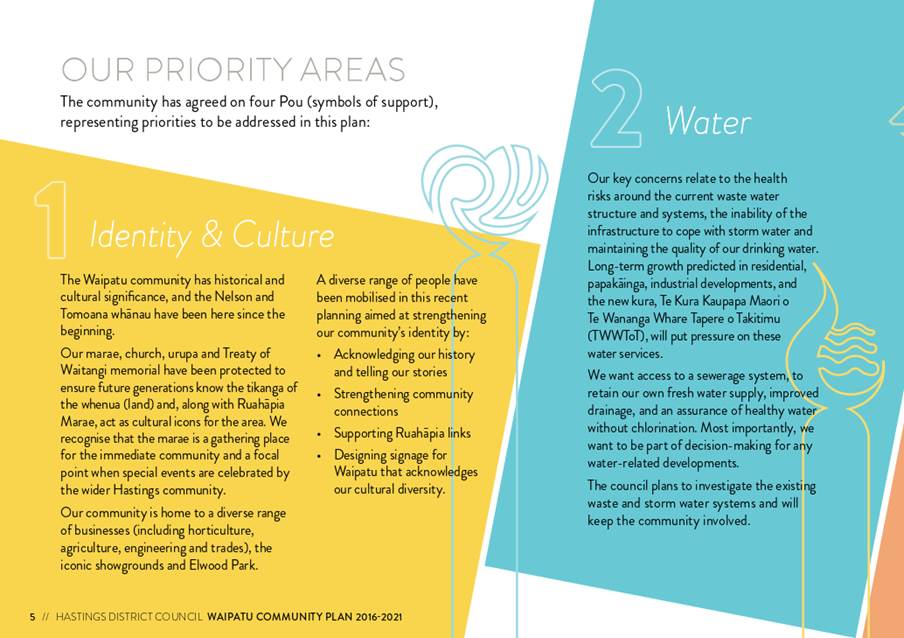




REPORT TO: Council
MEETING DATE: Thursday 11
July 2019
FROM: Project Advisor
Annette
Hilton
SUBJECT: Presentation
by Hawke's Bay Cancer Society
1.0 SUMMARY
1.1 The
purpose of this report is to inform the Council about today’s
presentation by the Hawke’s Bay Cancer Society regarding their Wellness
Centre.
1.2 Hawke’s
Bay Cancer Society President Melissa Horsefield and Cancer Wellness Centre
project director Trudy Kirk will be speaking at the meeting.
2.0 BACKGROUND
2.1 More
than 1000 people are diagnosed with cancer in Hawke’s Bay each year and
recent research figures predict that in 15 years, cancer diagnosis will
increase by 50%.
2.2 The
Cancer Society’s Wellness Centre on Orchard Road in Hastings aims to
reduce the impact cancer has on people in Hawke’s Bay and be a place that
gives a sense of nurturing and comfort.
2.3 The
Wellness Centre also intends to provide a safe and welcoming environment for
those living with and beyond cancer.
2.4 It is
hoped the project is completed by 2022 and has a fundraising goal of $6.5million
within two years.
2.5 Melissa
Horsefield and Trudy Kirk have come to update Council on the project.
|
3.0 RECOMMENDATIONS
AND REASONS
A) That
the report of the Project Advisor titled “Presentation by
Hawke's Bay Cancer Society dated 11/07/2019 be received.
|
Attachments:
There are no
attachments for this report.
REPORT TO: Council
MEETING DATE: Thursday 11
July 2019
FROM: Financial Policy Advisor
Ashley
Humphrey
SUBJECT: Resolution
to set the Rates for the 2019/20 Financial Year
1.0 SUMMARY
1.1 The
purpose of this report is to obtain a decision from the Council adopting the
Rates Resolution to set the rates for the 2019/20 Financial Year commencing 01
July.
1.2 The
Council is required to give effect to the purpose of local government as set
out in section 10 of the Local Government Act 2002. That purpose is to enable
democratic local decision-making and action by (and on behalf of) communities,
and to promote the social, economic, environmental, and cultural well-being of
communities in the present and for the future.
1.3 This
report concludes by recommending that the Council set the rates as detailed,
adopt the differential categories and the payment due and penalty dates set out
in the recommendation. All rates are shown as inclusive of Goods and Services
Tax of 15%.
2.0 BACKGROUND
2.1 Council adopted the 2019/20 Annual Plan, which identified the
Council’s budgetary requirements, at its meeting on 27 June 2019.
2.2 It now needs to assess and set the rates described in its Rating
Policy and Funding Impact Statement in order to collect the revenue needed for
the 2019/20 Financial Year commencing 01 July.
3.0 CURRENT
SITUATION
3.1 To
enable the rates to be levied on properties for 2019/20 the Council needs to
pass the resolution to set the rates for the 2019/20 Financial Year. This is a very
important procedural matter following the consultation which occurred during
the 2019/20 Annual Plan process.
3.2 The
rates have been calculated to ensure that the correct revenue is collected to
meet the budget.
4.0 OPTIONS
4.1 The attached resolutions enable the collection of Council’s
rate funding requirement based on the budget and policies adopted in the 2019/20
Annual Plan. This is the only option that allows Council to collect rates to
fund the expenditure requirements.
5.0 SIGNIFICANCE
AND ENGAGEMENT
5.1 While the striking of the rates is a significant decision, no
consultation is required as the resolution is a procedural matter to implement
policies and the budgeted requirements that have already been consulted on via
the 2019/20 Annual Plan adopted under the Local Government Act 2002.
|
6.0 RECOMMENDATIONS
AND REASONS
A) That
the report of the Financial Policy Advisor titled “Resolution
to set the Rates for the 2019/20 Financial Year” dated 11/07/2019
be received.
B) That pursuant to the Local Government (Rating) Act 2002, the
Hastings District Council makes the rates on rating units in the District for
the financial year commencing on 1 July 2019 and ending on 30 June 2020 and
adopts the due dates and penalty dates for the 2019/20 financial year, as
follows:
INTRODUCTION
Hastings District
Council has adopted its 2019/20 Plan. This has identified the
Council’s budget requirement, and set out the rating policy and funding
impact statement. The Council hereby sets the rates described below to
collect its identified revenue needs for 2019/20 commencing 01 July
2019. All rates are inclusive of Goods and Services Tax.
GENERAL RATES
A
general rate set and assessed in accordance with Section 13 of the Local
Government (Rating) Act 2002, on the land value of all rateable land within
the district on a differential basis as set out below:

UNIFORM ANNUAL GENERAL CHARGE
A
uniform annual general charge set and assessed in accordance with Section 15
of the Local Government (Rating) Act 2002, of $206 on each separately used or
inhabited part of a rating unit within the district.
TARGETED RATES
All differential categories of targeted rates areas
are as defined in the Funding Impact Statement for 2019/20. For the purposes
of the Havelock North Promotion, Hastings City Marketing, Hastings CBD
Targeted Rate, Havelock North CBD Targeted Rate, and Security
Patrols (Hastings and Havelock North), a commercial rating unit is one
that fits the description as set out under DRA1 CBD Commercial and DRA1 Other
Commercial in Part B of the Funding Impact Statement for 2019/20.
COMMUNITY SERVICES & RESOURCE MANAGEMENT RATE
A
targeted rate set and assessed in accordance with Section 16 of the Local
Government (Rating) Act 2002, on a differential basis, on each separately
used or inhabited part of a rating unit as follows:

HAVELOCK NORTH
PROMOTION
A
targeted rate set and assessed in accordance with Section 16 of the Local
Government (Rating) Act 2002, on the land value of any commercial rating unit
located within Havelock North as defined on Council Map “Havelock North
Promotion Rate”, of 0.1595 cents per dollar of land value.
SWIMMING POOL SAFETY
A
targeted rate set and assessed in accordance with Section 16 of the Local
Government (Rating) Act 2002, as a fixed amount on every rating unit where a
swimming pool (within the meaning of the Fencing of Swimming Pools Act 1987)
is located, of $61 per rating unit.
HAVELOCK NORTH PARKING
A
targeted rate set and assessed in accordance with Section 16 of the Local
Government (Rating) Act 2002, on a differential basis, on each separately
used or inhabited rating unit located within Havelock North as defined on
Council Map “Havelock North Parking”, as follows:

HASTINGS CITY MARKETING
A
targeted rate set and assessed in accordance with Section 16 of the Local
Government (Rating) Act 2002, on the land value of any commercial rating
units located within Hastings as defined on Council Map “Hastings City
Marketing Rate”, of 0.2610 cents per dollar of land value.
HASTINGS CBD TARGETED RATE
A
targeted rate set and assessed in accordance with Section 16 of the Local
Government (Rating) Act 2002, on the land value of any commercial rating unit
located within Hastings as defined on the Council Map “Hastings
CBD”, of 0.1660 cents per dollar of land value.
HAVELOCK NORTH CBD TARGETED RATE
A
targeted rate set and assessed in accordance with Section 16 of the Local
Government (Rating) Act 2002, on the land value of any commercial rating unit
located within Havelock North as defined on Council Map “Havelock North
CBD”, of 0.0781 cents per dollar of land value.
SECURITY PATROLS
Targeted
rates set and assessed in accordance with Section 16 of the Local Government
(Rating) Act 2002, on the land value of any commercial rating unit located
within each respective Council Map defined “Hastings Security Patrol
Area” and “Havelock North Security Patrol Area”, as
follows:
Hastings
Security Patrol Area - 0.1037 cents per dollar of land value.
Havelock
North Security Patrol Area - 0.0624 cents per dollar of land value.
SEWAGE DISPOSAL
A
differential targeted rate set and assessed in accordance with Section 16 of
the Local Government (Rating) Act 2002, based on the provision or
availability to the land of the service. The rate is set as an amount per
separately used or inhabited part of a rating unit.
A
differential targeted rate for all non-residential rating units classified as
“connected”, based on the use to which the land is put. The rate
is an amount for each water closet or urinal after the first.
The rates apply to connected or serviceable rating
units in all areas excluding those in the Waipatiki scheme area.
The rates for the 2019/20 year are:

Where connected, in the case of non-residential use,
the differential charge for each water closet or urinal after the first is as
follows:

WAIPATIKI SEWAGE DISPOSAL
A
differential targeted rate set and assessed in accordance with Section 16 of
the Local Government (Rating) Act 2002, based on the provision or
availability to the land of the service. The rate is set as an amount per
separately used or inhabited part of a rating unit.
This
rate applies only to connected or serviceable rating units in the Waipatiki
scheme area.
The rates for the 2019/20 year are:

Where connected, in the case of non-residential use,
the differential charge is set for each water closet or urinal after the
first as follows:
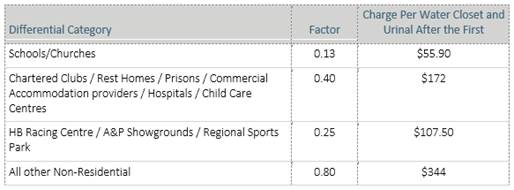
WASTEWATER TREATMENT
A
differential targeted rate set and assessed in accordance with Section 16 of
the Local Government (Rating) Act 2002, based on the provision or
availability to the land of the service. The rate is set as an amount per
separately used or inhabited part of a rating unit.
A
differential targeted rate for non-residential rating units classified as
“connected”, based on the use to which the land is put. The rate
is an amount for each water closet or urinal after the first.
The rates apply to connected or
serviceable rating units in all areas excluding those in the Waipatiki scheme
area.
The rates for the 2019/20 year are:

Where connected, in the case of non-residential use,
the differential charge is set for each water closet or urinal after the
first as follows:
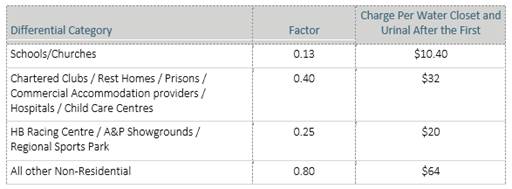
WATER SUPPLY
Targeted
rates set and assessed in accordance with Section 16 of the Local Government
(Rating) Act 2002, on each separately used or inhabited part of a rating unit
and based on the provision or availability to the land of the service, on a
differential basis as follows:
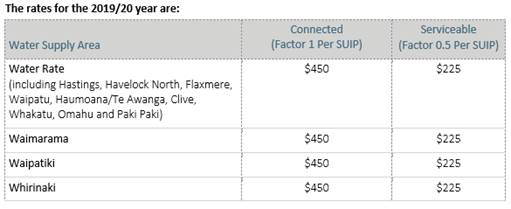
WATER BY METER
A
targeted rate set and assessed in accordance with Section 19 of the Local
Government (Rating) Act 2002, on the volume of water supplied as
extraordinary water supply, as defined in Hastings District Council Water
Services Policy Manual (this includes but is not limited to residential
properties over 1,500m2 containing a single dwelling, lifestyle lots, trade
premises, industrial and horticultural properties) of $0.78 per cubic metre
of water supplied over and above the typical household consumption as defined
in the Hastings District Council Water Services Policy Manual.
RECYCLING
A
targeted rate set and assessed in accordance with Section 16 of the Local
Government (Rating) Act 2002, on each separately used or inhabited part of a
rating unit and based on the provision or availability to the land of the
service provided in the serviced area, of $43 per separately used or
inhabited part of the rating unit.
REFUSE
A
targeted rate set and assessed in accordance with Section 16 of the Local
Government (Rating) Act 2002, on each separately used or inhabited part of a
rating unit, differentiated based on the use to which the land is put.
Residential
rating units currently receive a weekly collection. Commercial rating
units located within Hastings as defined on Council Map “Hastings CBD
Refuse”, and located within Havelock North as defined on Council Map
“Havelock North CBD Refuse” currently receive a twice weekly
collection.
The
rate for 2019/20 is:

WAIMARAMA REFUSE
A
targeted rate set and assessed in accordance with Section 16 of the Local
Government (Rating) Act 2002, on each separately used or inhabited part of a
rating unit located within Waimarama as defined on Council Map
“Waimarama Refuse Collection”, and based on the provision or
availability to the land of the service provided, of $80 per separately used
or inhabited part of the rating unit.
CAPITAL COST OF SUPPLY EXTENSIONS
Targeted
rates set and assessed in accordance with Section 16 of the Local Government
(Rating) Act 2002, on each separately used or inhabited part of a rating
unit, and based on the provision or availability to the land of the service
provided, to fund the capital cost of the extension to the water supply and
sewerage networks in each of the following locations, as follows:
Whirinaki Water Supply:
$270
per separately used or inhabited part of a rating unit (over 4 instalments)
for those rating units where the ratepayer elected for a 25 year targeted
rate option and elected not to pay a lump sum option at the time of scheme
inception.
Waipatiki Sewage Disposal:
$1,312
per separately used or inhabited part of a rating unit (over 4 instalments)
for those rating units where the ratepayer elected for a 10 year targeted
rate option and elected not to pay a lump sum option at the time of scheme
inception.
WAIMARAMA SEA WALL
A
targeted rate set and assessed in accordance with Section 16 of the Local
Government (Rating) Act 2002 on a differential basis, on each separately used
or inhabited part of a rating
unit within each individual zone defined on Council Map “Waimarama Sea
Wall Zone” of the following amounts per separately used or inhabited
part of the rating unit:
Zone
1 shall pay 67% of the cost to be funded, whilst Zone 2 shall pay 23% of the
cost and Zone 3 10% of the cost, based on the extent of the provision of
service.
|
Zone 1
|
$270
|
Zone 2
|
$187
|
Zone 3
|
$70
|
DUE DATES AND PENALTY DATES
Due Dates for Payment and Penalty Dates (for Rates other than Water
by Meter Rates):
The
Council sets the following due dates for payment of rates (other than Water
by Meter) and authorises the addition of penalties to rates not paid on or by
the due date, as follows:
Rates
will be assessed by quarterly instalments over the whole of the district on
the due dates below:
|
Instalment
|
Due Date
|
Penalty Date
|
|
1
|
23 August 2019
|
28 August 2019
|
|
2
|
22 November 2019
|
27 November 2019
|
|
3
|
21 February 2020
|
26 February 2020
|
|
4
|
22 May 2020
|
27 May 2020
|
A penalty of 10% will be added to any portion of
rates (except for Water by Meter) assessed in the current year which remains
unpaid after the relevant instalment due date, on the respective penalty date
above.
Arrears Penalties on Unpaid Rates from Previous Years
Any portion of rates assessed in previous years (including previously
applied penalties) which remains unpaid on 17 July 2019 will have a further
10% added. The penalty will be added on 18 July 2019.
A further additional penalty of 10% will be added to any portion of rates
assessed in previous years which remains unpaid on 19 January 2020. The
penalty will be added on 20 January 2020.
Due Dates for Payment and Penalty Dates (for Water
by Meter Rates):
For
those properties that have a metered water supply, invoices will be issued
either three-monthly or six-monthly.
Three
Monthly Invoicing:
|
Instalment
|
Invoicing Due Date
|
Penalty Date
|
|
1
|
21 October 2019
|
22 October 2019
|
|
2
|
20 January 2020
|
21 January 2020
|
|
3
|
20 April 2020
|
21 April 2020
|
|
4
|
20 July 2020
|
21 July 2020
|
Six
Monthly Invoicing:
|
Instalment
|
Invoicing Due Date
|
Penalty Date
|
|
1
|
20 January 2020
|
21 January 2020
|
|
2
|
20 July 2020
|
21 July 2020
|
A penalty of 10% will be added to any portion of
water supplied by meter, assessed in the current year, which remains unpaid
after the relevant instalment due date, on the respective penalty date above.
Arrears Penalties on Unpaid Water by Meter Rates from
Previous Years
Any portion of Water by Meter rates assessed in previous years
(including previously applied penalties) which remains unpaid on 22 July 2019
will have a further 10% added. The penalty will be added on 23 July 2019.
A further additional penalty of 10% will be added to any portion of rates
assessed in previous years which remains unpaid on 22 January 2019. The
penalty will be added on 23 January 2019.
With the reasons for this
decision being:
The Council is required to
collect funds from rates on properties to undertake the functions outlined in
the 2019/20 Plan.
|
Attachments:
There are no
attachments for this report.
REPORT TO: Council
MEETING DATE: Thursday 11
July 2019
FROM: Team Leader Environmental Health
and Liquor Licensing
Tony
Stothart
SUBJECT: Hastings
District and Napier City Council’s joint Local Alcohol Policy (the LAP)
1.0 SUMMARY
1.1 The
purpose of this report is to obtain a resolution from Council on setting a date
at which the Hastings District and Napier City Council’s joint Local
Alcohol Policy (the LAP) comes into force (Attachment One).
1.2 The
resolution is required by Section 90 of the Sale and
Supply of Alcohol Act 2012. A similar report will also go before the full
Napier City Council on 20 August 2019 as part of the process.
1.3 This
report concludes by recommending:
· The Local Alcohol Policy is publicly notified
· The Local Alcohol Policy comes into force on 21 August 2019
· The Local Alcohol Policy hours provision in Section 5 of the LAP,
come into force on 21 November 2019
· The LAP is considered for review in 3 years with a compulsory full
review at 6 years after it comes into force.
2.0 BACKGROUND
2.1 In
late 2012 Hastings District Council and Napier City Council resolved to develop
a joint LAP for Hastings and Napier. Accordingly, a draft LAP was
developed as per the requirements of the Sale and Supply of Alcohol Act 2012.
2.2 The
draft LAP became provisional in 2016 and was subsequently appealed as a result
of the public notification process.
2.3 The
appeals were resolved in 2019 and the PLAP was adopted by the Alcohol
Regulatory and Licensing Authority (ARLA) on 12 June 2019.
2.4 A
summary of the development process (Attachment two) and ARLA decision (Attachment
three) are appended to this report.
2.5 The
status quo for licensing hours remains in place until the LAP comes into force.
Summary of LAP
provisions
2.6 The
LAP includes the following provisions:
|
.On-Licence type
|
Maximum Trading
Hours
|
|
Taverns/bars/pubs/night-clubs
|
8.00am to 3.00am the following day
Monday to Sunday
One way door restriction:
Mandatory at 2 am
|
|
Cafes/restaurants/wineries/winery
restaurants
|
8.00am to 2.00am the following day
Monday to Sunday
|
|
Entertainment Venues
|
Licensing hours are to be consistent
with the nature and activities of the premise and in general shall range
from:
8.00am to 2.00am the following day
Monday to Sunday
|
|
Off Licence
Type
|
Maximum Trading
Hours
|
|
Supermarkets and Grocery Stores
|
7.00am to 10.00pm Monday to Sunday
|
|
All other off licenses
|
9.00am to 10.00pm Monday to Sunday
|
|
Club Licence
Type
|
Maximum Trading
Hours
|
|
8.00am to 1.00am the following day
Monday to Sunday
|
|
Special Licence
Provisions:
|
|
SSAA default conditions apply
|
|
Location of
Licensed Premises (density controls):
|
|
No further off-licences are
to be issued for any premises being a bottle store on land located within:
Flaxmere - the Commercial Service or Suburban Commercial zone
in Flaxmere, or any Precinct within the Flaxmere Village Centre Zone or
Scheduled sites 1 and 2 within Flaxmere
Camberley - the suburban commercial zone in Camberley
Maraenui – the Reserve, Suburban Commercial and
Residential Zone in Maraenui
|
|
DISCRETIONARY
Conditions
|
|
Various
|
|
|
|
3.0 SIGNIFICANCE
AND ENGAGEMENT
3.1 A
Special Consultative Procedure was completed as a part of the development of
the joint LAP.
3.2 There
was extensive consultation with the NZ Police and Hawke’s Bay District
Health Board as required by the Sale and Supply of Alcohol Act 2012.
3.3 Additional
evidence gathering was completed in 2018 to reassess the council’s policy
position.
4.0 FUTURE
REVIEWS
4.1 Section
97 of the Sale and Supply of Alcohol Act 2012 requires that a LAP must be
reviewed no later than 6 years after it came into force. Recommendation
6C) of the report takes into account this requirement.
5.0 CONCLUDING
COMMENTS
5.1 The LAP has been through thorough public consultation and has
required a high level of evidence to support the provisions.
5.2 New evidence
was examined in 2018 from both the District Health Board and the NZ Police to
show that the councils did not have sufficient evidence to support stronger
restrictions. This was then confirmed by legal advice provided by in
house legal counsel and external legal support from Katia Fraser from Meredith
Connell, a top lawyer in this industry.
5.3 In December 2018, it was five years since the regulations relating
to LAPs were implemented. Thirty Two of the 33
LAPs around the country were appealed and in most cases the appeals resulted in
lesser restrictions (longer trading hours) for premises.
5.4 Each
appeal process on average took 2 years one month and 28 days to settle, leaving
the less restrictive national default provisions to be in force in the interim.
5.5 The Hastings
District Council and Napier City Council Joint LAP is one of the only LAPs
around the country that has successfully gained a restriction on further
licences being issued for bottle stores in a specific area.
5.6 In
light of the evidence to support the LAP position, the adoption of the LAP is a
positive outcome and the provisions under the joint LAP will further protect
the community from alcohol related harm.
|
6.0 RECOMMENDATIONS
AND REASONS
A) That
the report of the Team Leader Environmental Health and Liquor
Licensing titled “Hastings District and Napier City
Council’s joint Local Alcohol Policy (the LAP)” dated 11/07/2019
be received.
B) That in accordance with Section 90 of the Sale and Supply of
Alcohol Act 2012:
· The Local Alcohol Policy is publicly notified
· The Local
Alcohol Policy comes into force on 21 August 2019
· The Local
Alcohol Policy hours provision in Section 5 of the Local Alcohol Policy, come
into force on 21 November 2019.
C) That a preliminary review be considered in three years after the
policy becomes operative with a full review required within 6 years of the
enforcement date.
D) That
a research working party of the key agencies is developed to start gathering
evidence to support the review of the policy required in 6 years by the Sale
and Supply of Alcohol Act 2012.
With the reasons for this decision
being that the objective of the decision will contribute to meeting the
current and future needs of communities.
|
Attachments:
|
1
|
LAP document
|
REG-14-3-19-237
|
|
|
2
|
Summary of LAP development process
|
REG-14-3-19-235
|
|
|
3
|
ARLA decision
|
REG-14-3-19-233
|
|
|
LAP document
|
Attachment 1
|
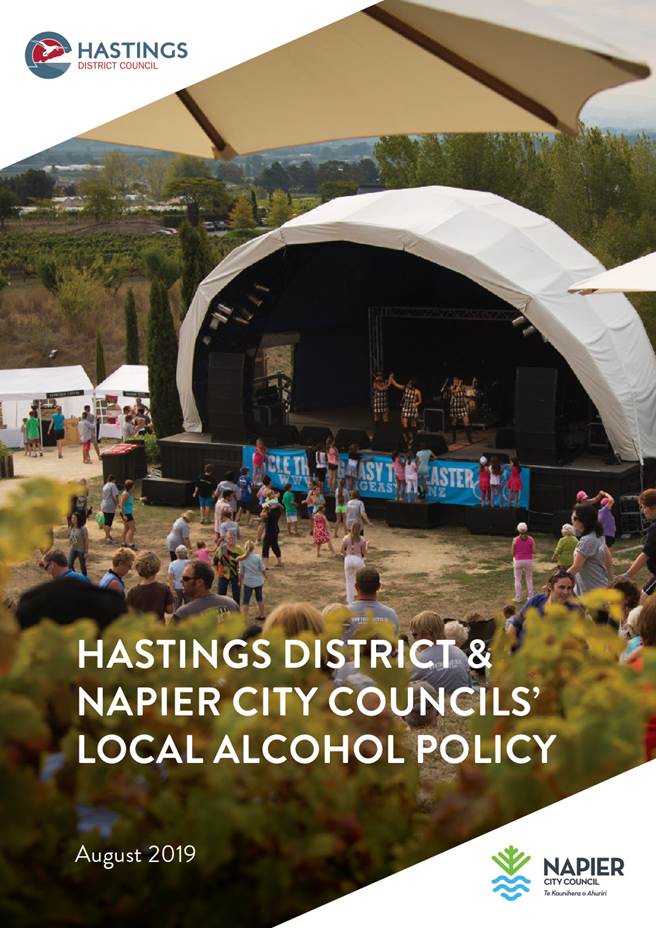
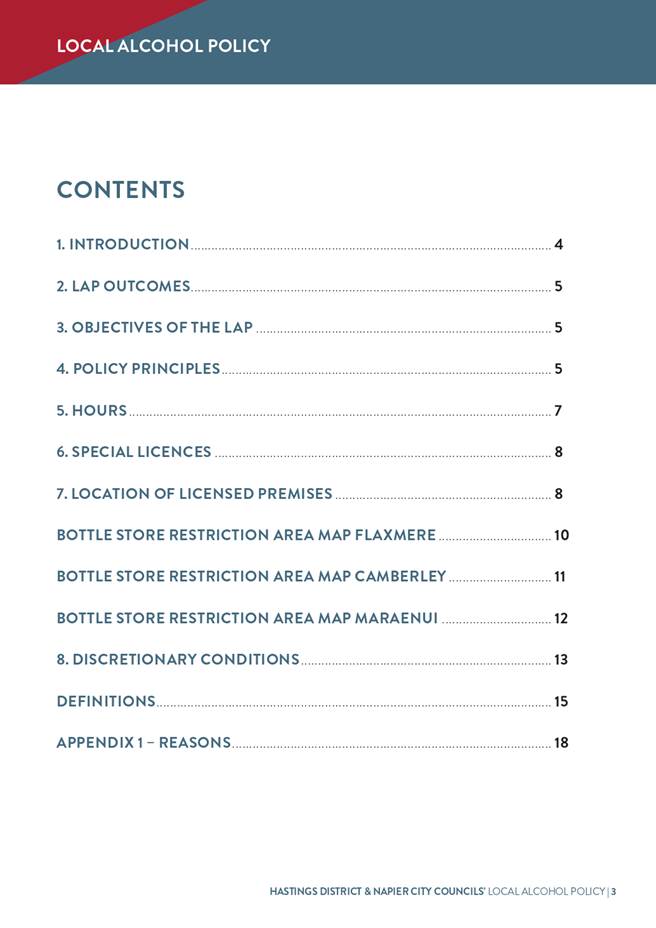
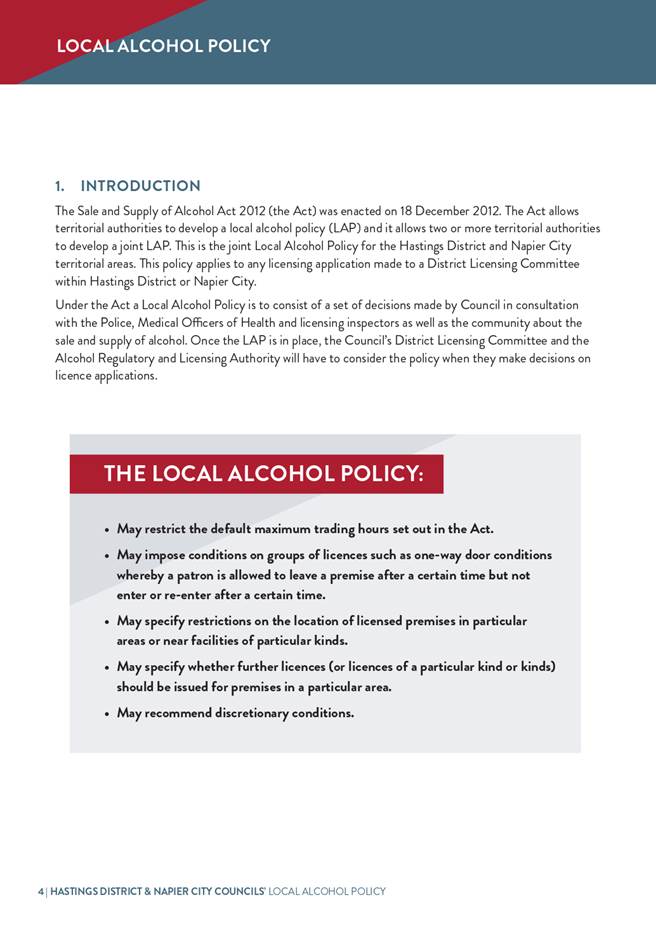
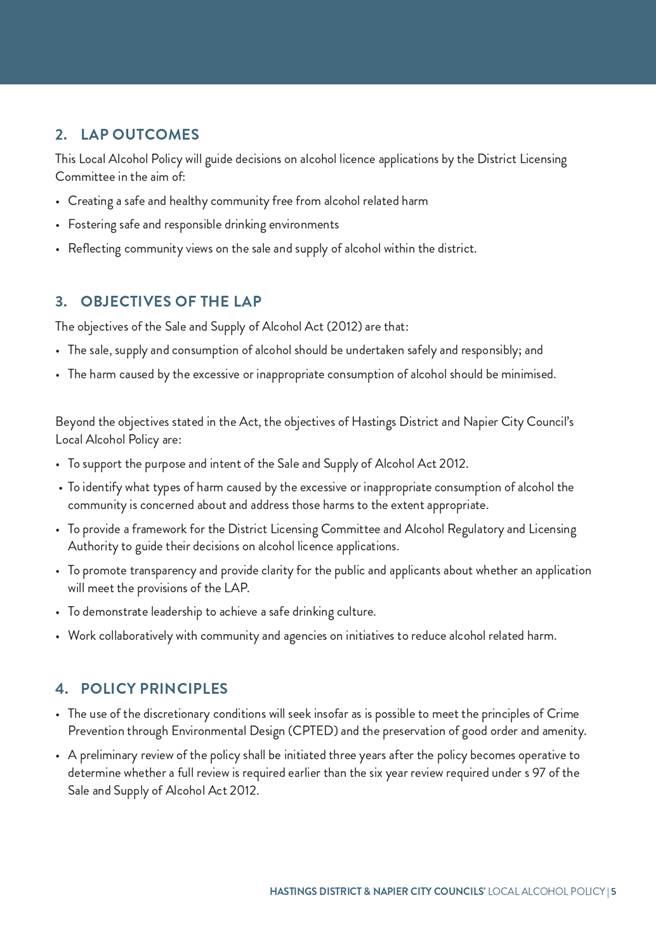
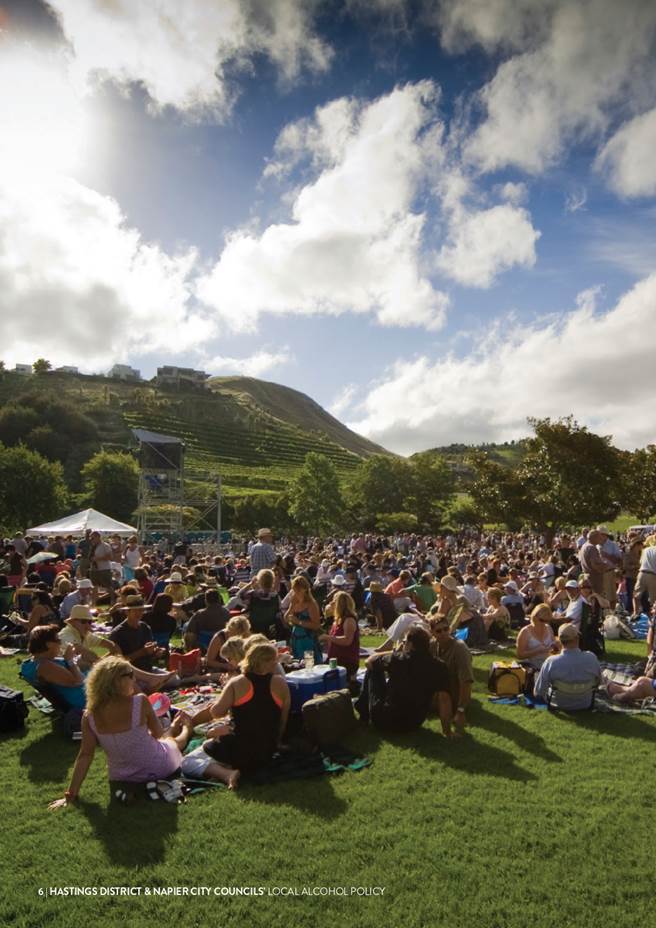
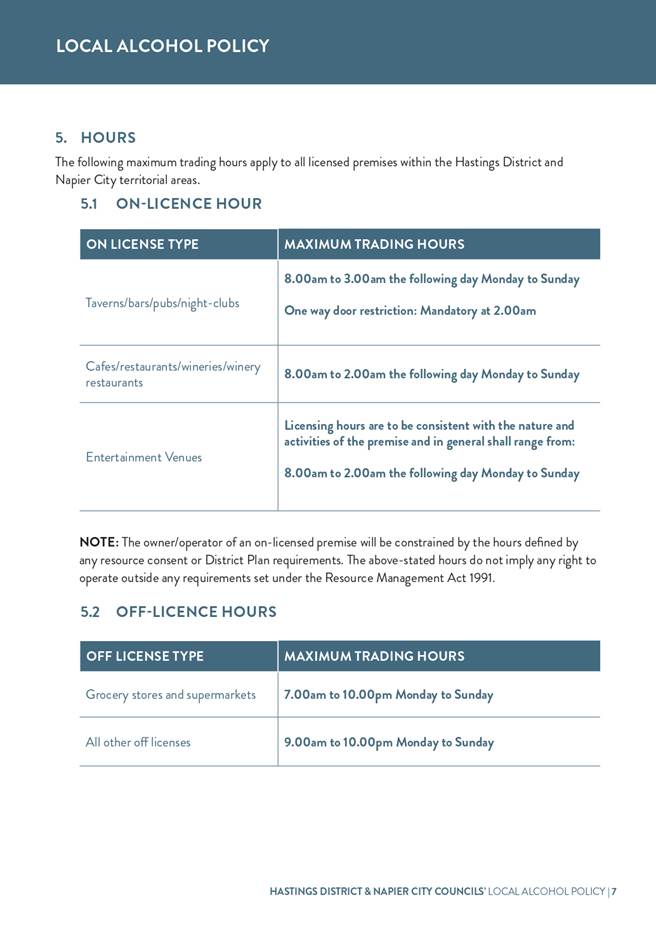
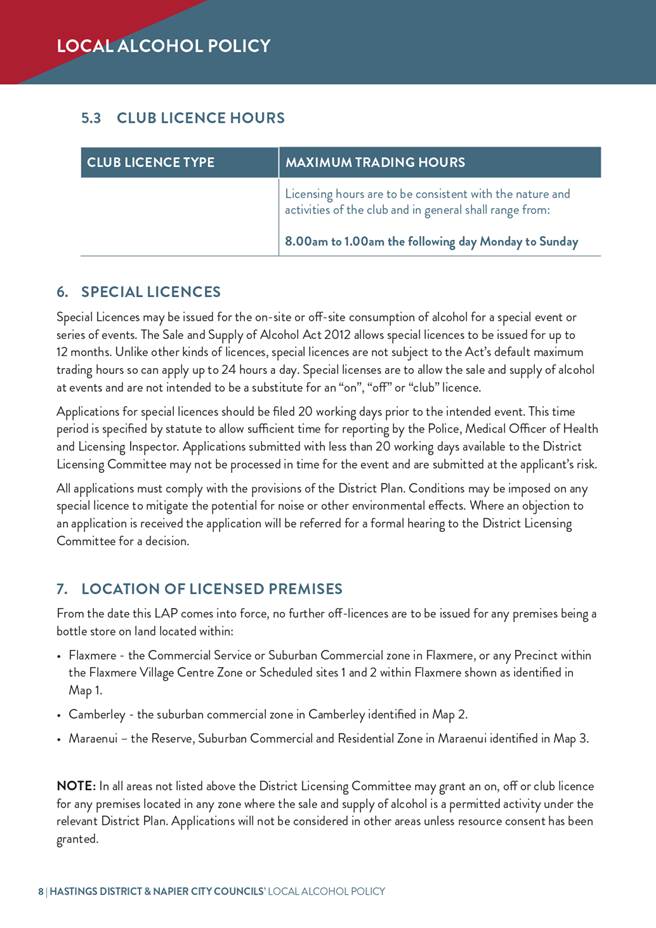
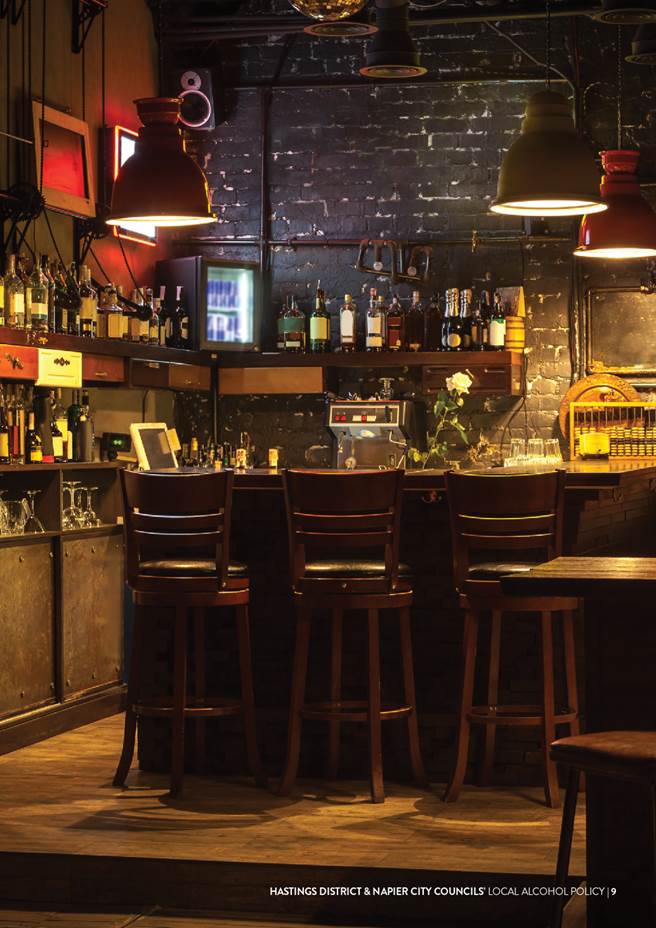
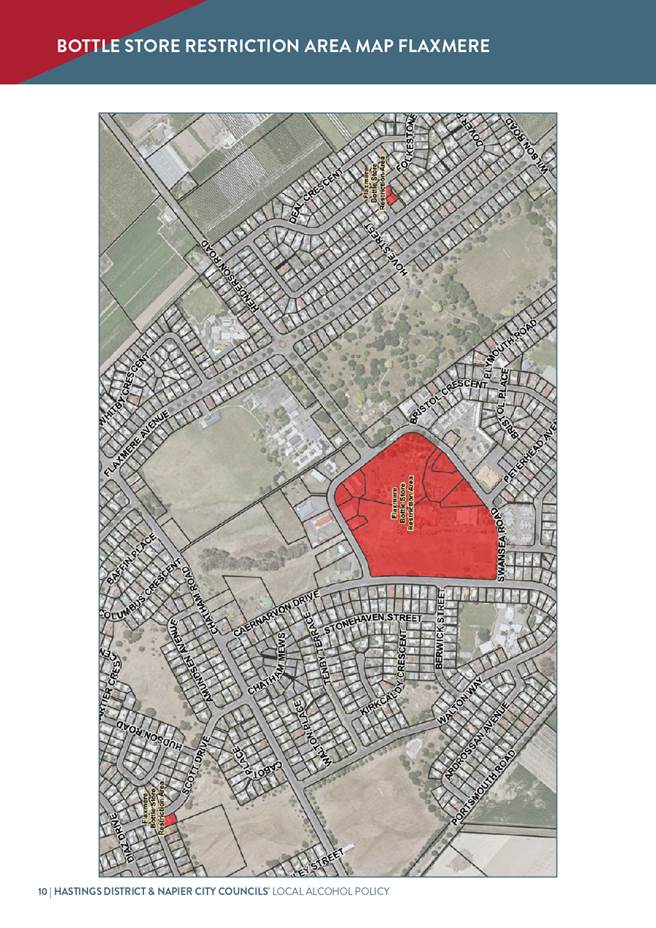
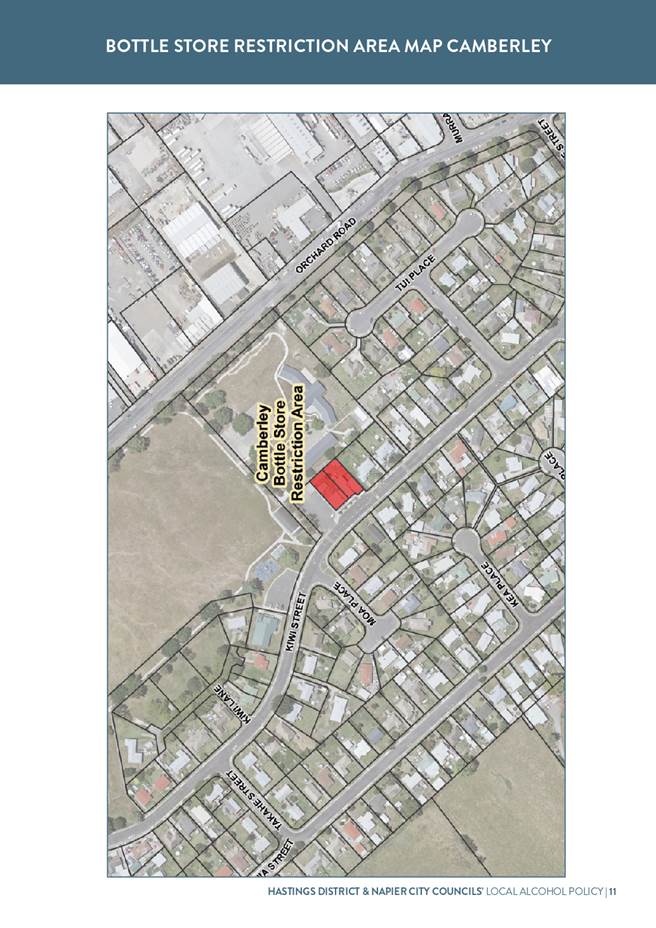
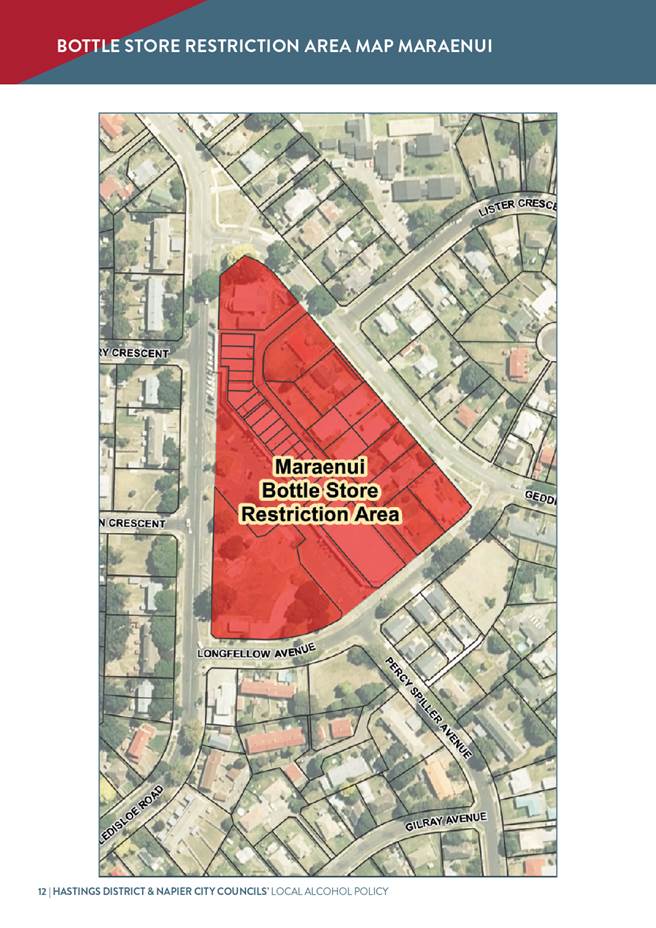
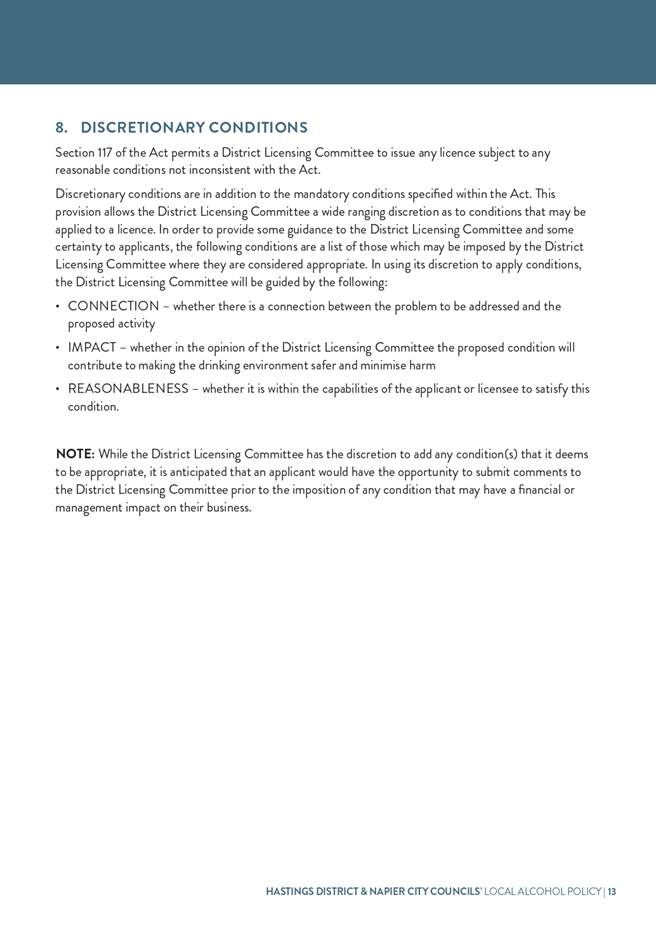
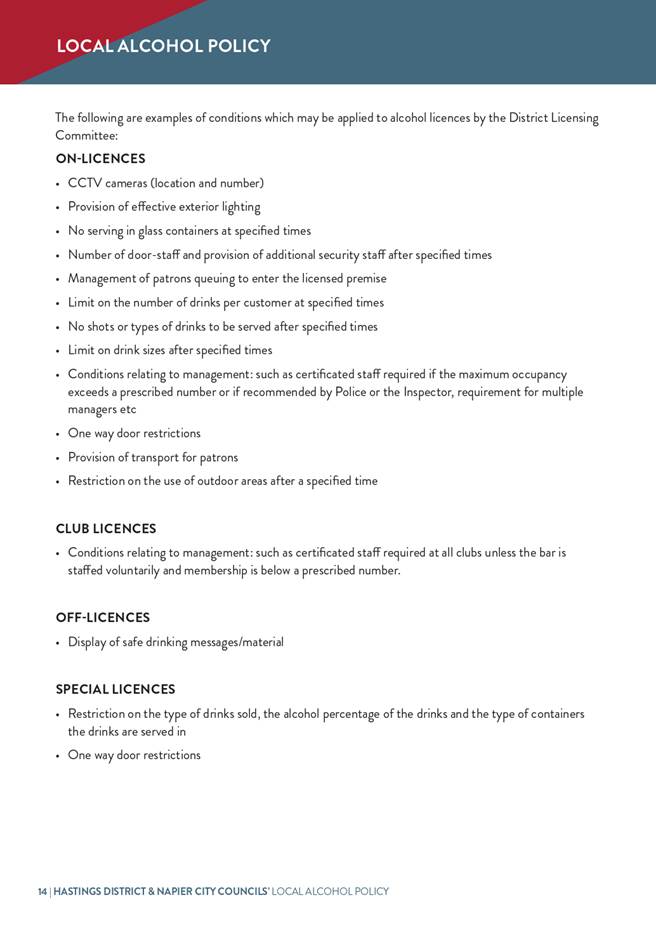
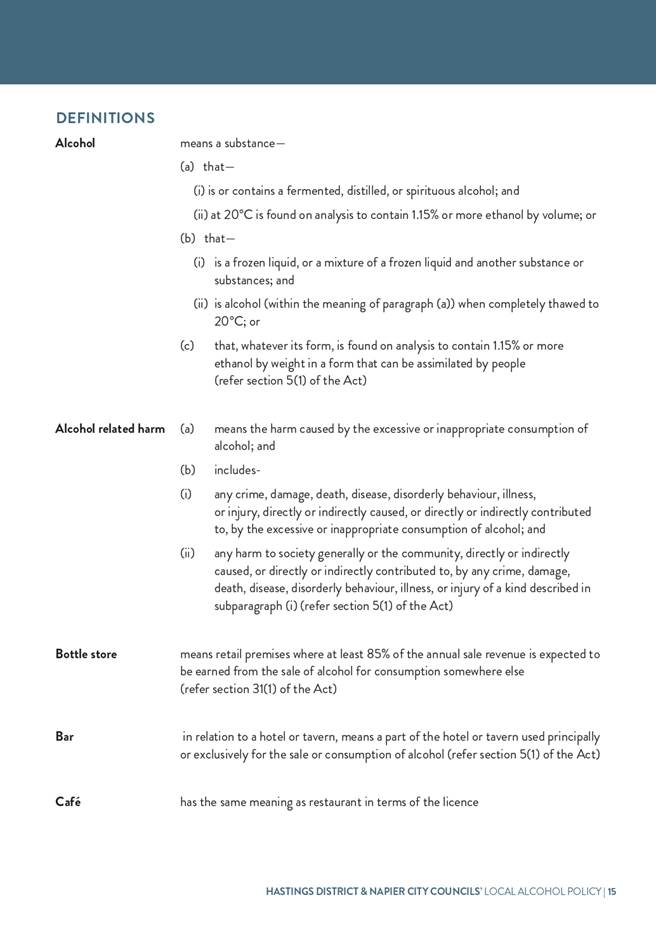
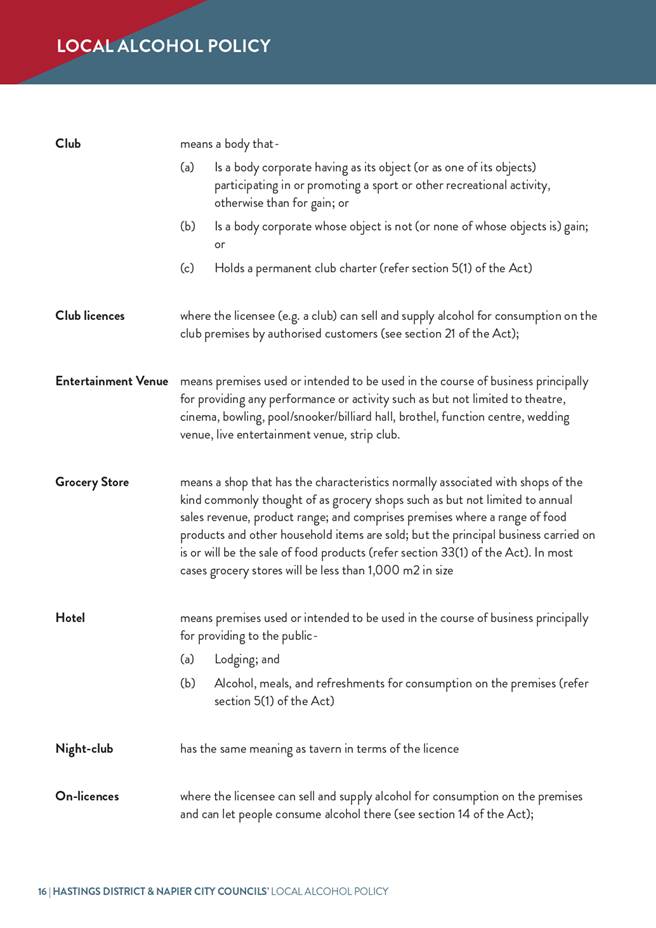
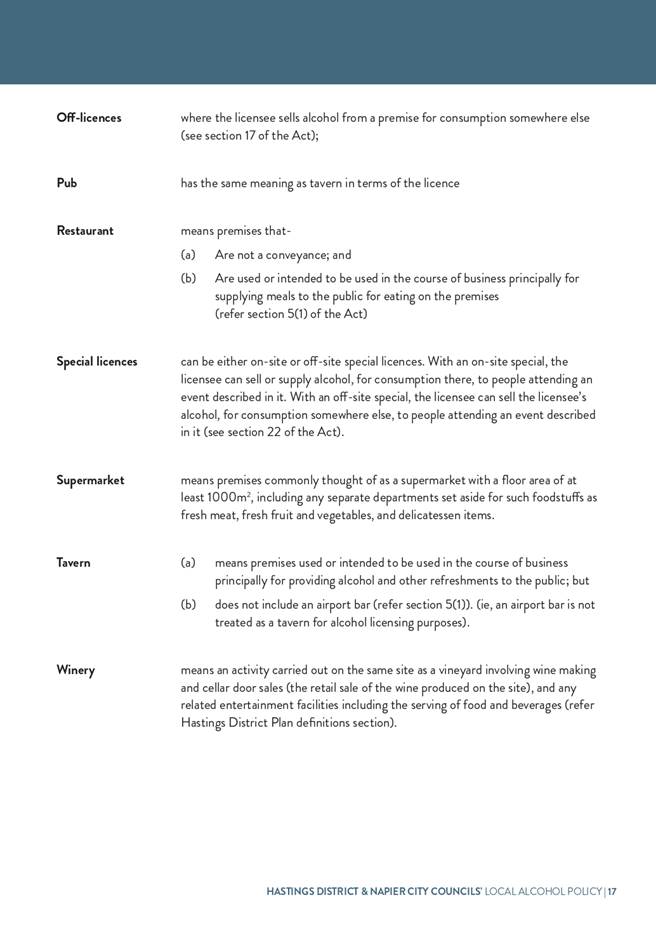
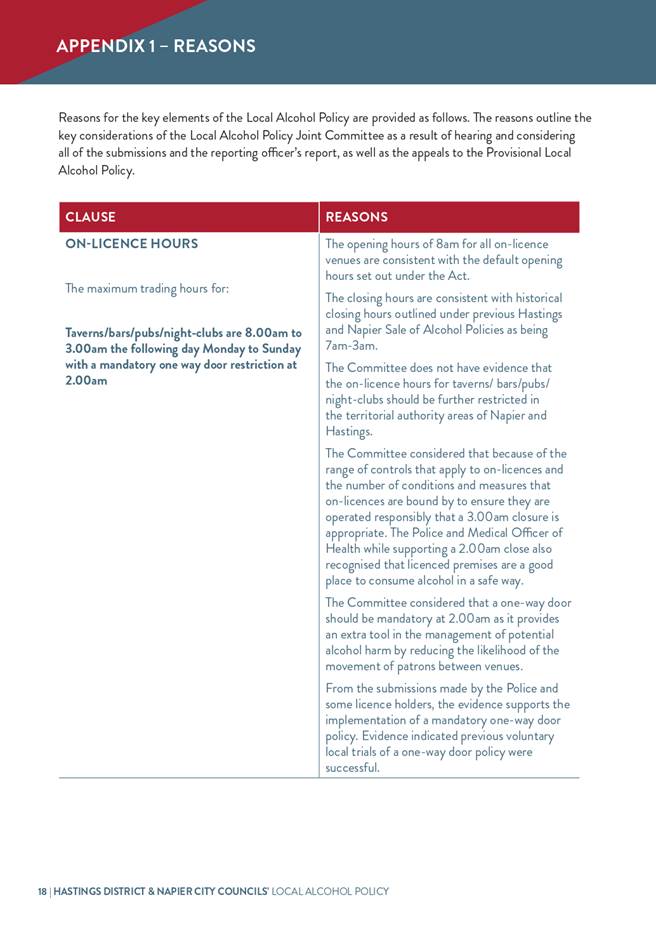
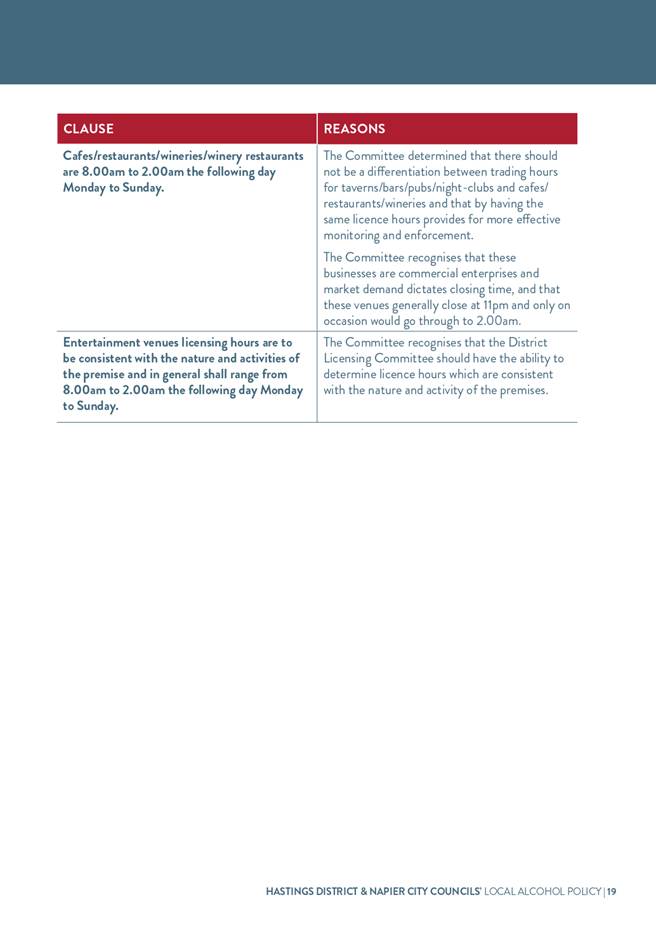
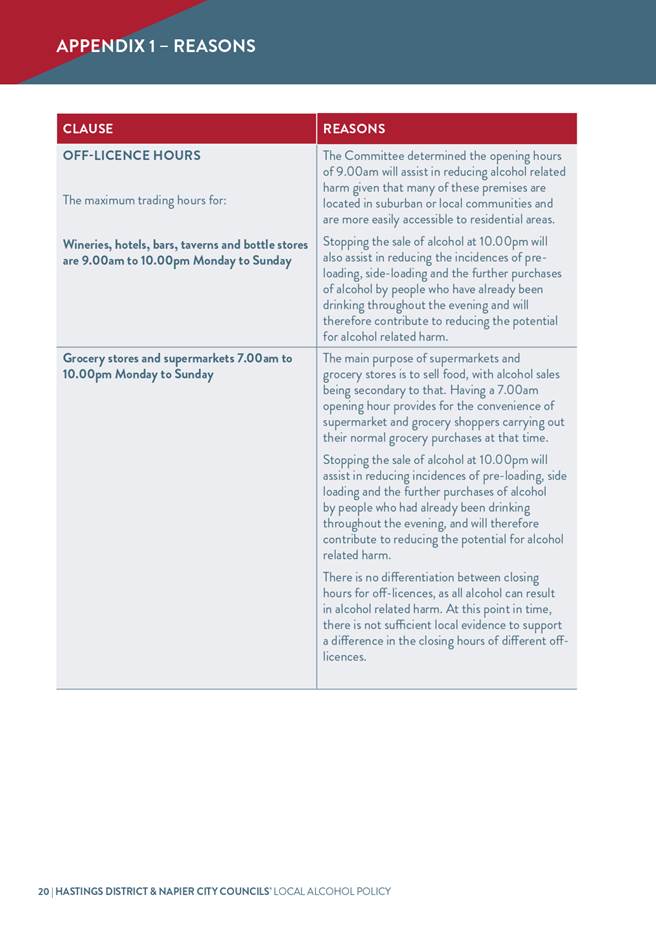
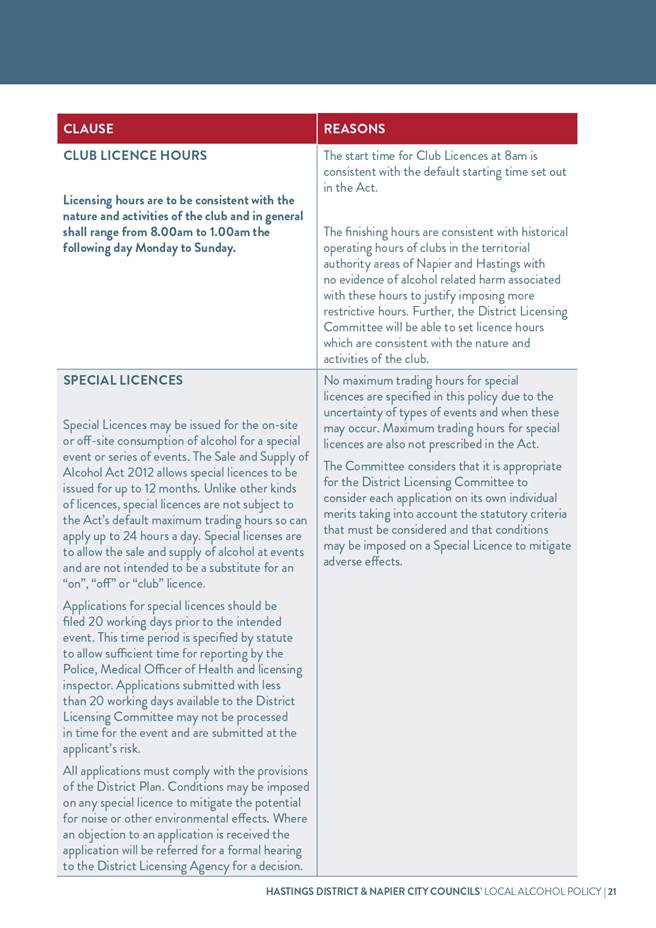
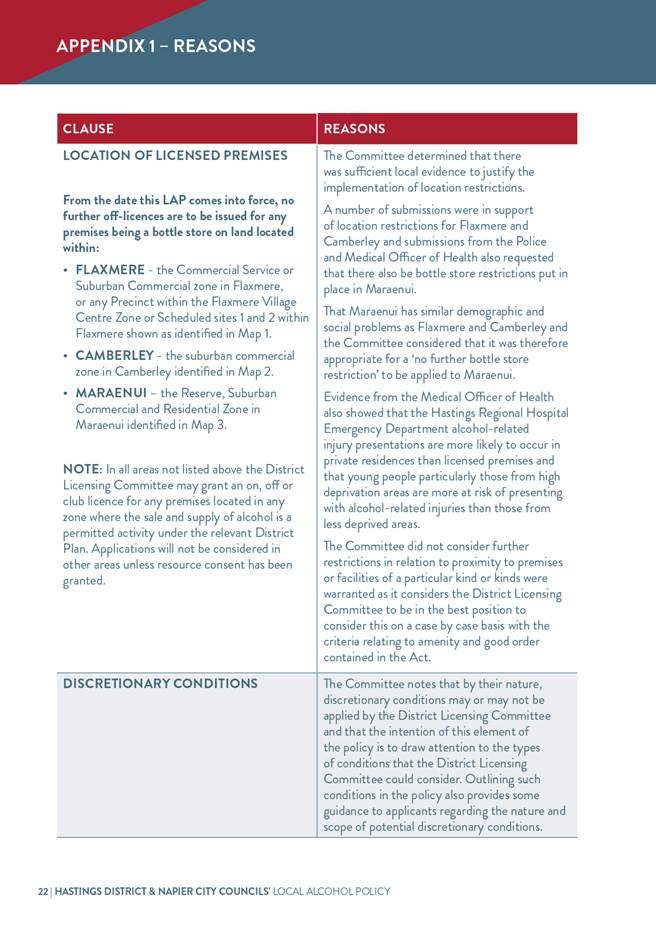

|
Summary of LAP development process
|
Attachment 2
|

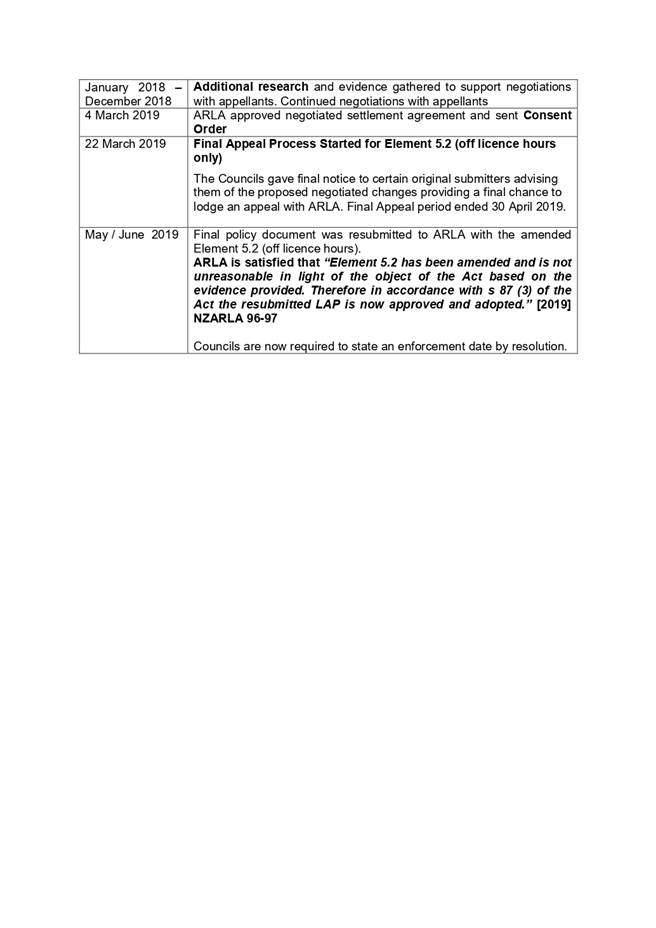
|
ARLA decision
|
Attachment 3
|
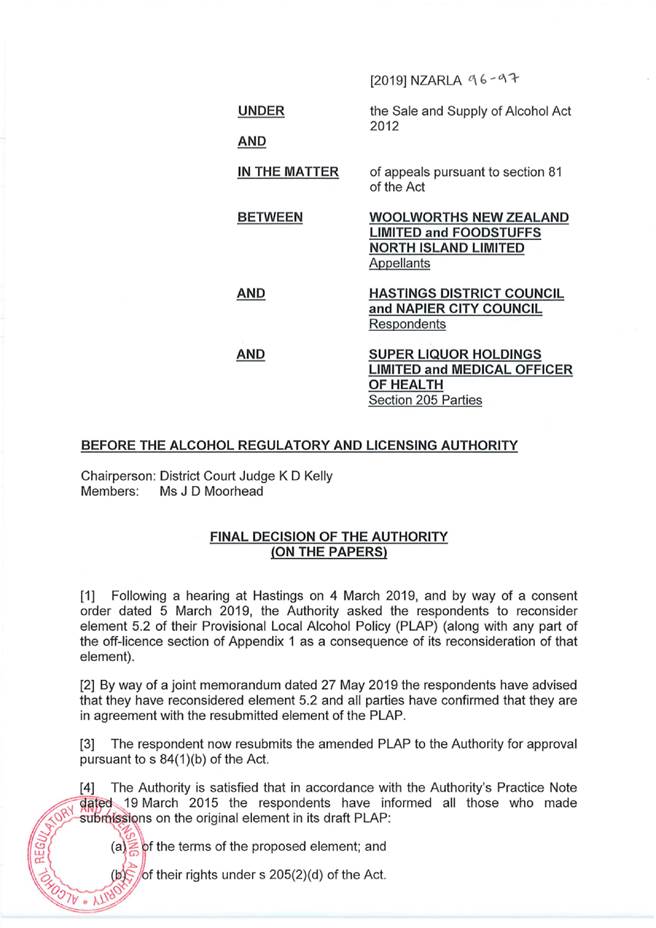
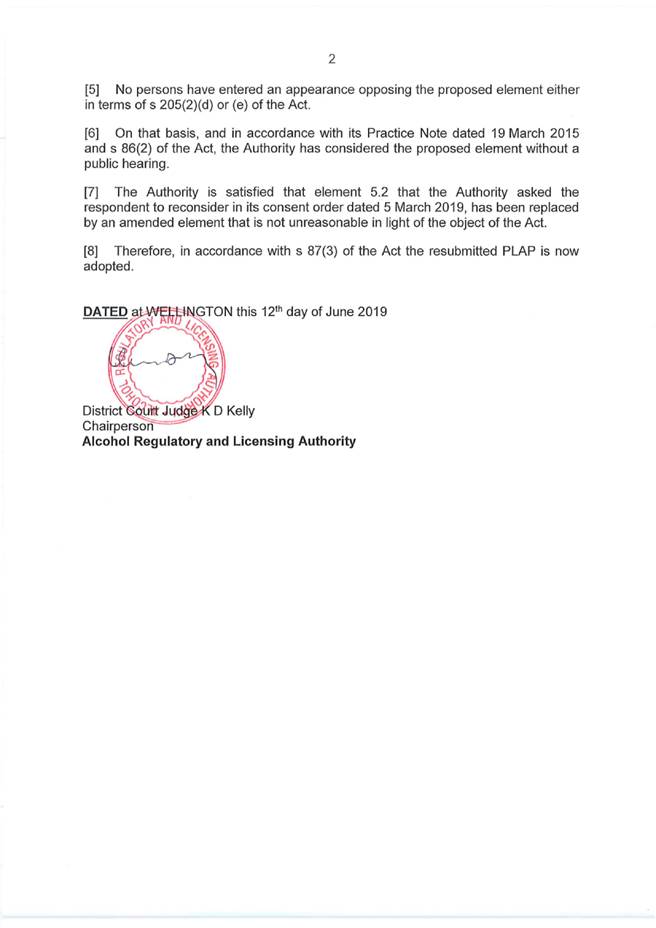
REPORT TO: Council
MEETING DATE: Thursday 11
July 2019
FROM: Hastings City Art Gallery Director
Toni
MacKinnon
SUBJECT: Toi-Tū
Hawke's Bay Strategic Framework
1.0 SUMMARY
1.1 The
purpose of this report is to seek approval for the Toi-Tū Hawke’s
Bay Strategic Framework 2019-2021.
1.2 The
Strategic Framework guides strategy, identifies areas of focus, gives clear
directions and enables actions to be measured.
1.3 The
Strategic Framework has been led by the Hastings District Council and guided by
the creative sector.
1.4 More
than twenty creative sector entities were consulted at various stages in the
development process of Toi-Tū. Mana whenua were key stakeholders
throughout the consultation and development process.
1.5 Throughout consultation the creative sector identified five key needs.
Identity, creativity and sustainability was to be the key
focus. That building strong leadership was critical and measuring against wellbeing.
1.6 The Strategic Framework identities opportunities to work across all
of Council to enable creativity and cohesion that will enrich the work Councils
does that benefits the community as a whole.
1.7 The
Council is required to give effect to the purpose of local government as set
out in section 10 of the Local Government Act 2002. That purpose is to enable
democratic local decision-making and action by (and on behalf of) communities,
and to promote the social, economic, environmental, and cultural well-being of
communities in the present and for the future.
1.8 This
report concludes by recommending the ‘Toi-Tū Hawke’s Bay
Strategic Framework’ dated 11 July 2019 be approved.
2.0 BACKGROUND
2.1 In response to requests from the creative sector, Toi-Tū
Hawke’s Bay Strategic Framework was commissioned by Hastings District
Council in 2017. Councillors directed Officers to pursue a creative sector-led
framework.
2.2 Officers
presented the framework to Council in August 2018. While Councillors supported
the framework in principle, they asked Officers to investigate regional
partnerships in the development of the framework.
2.3 Officers
reported back to Council in November 2018 that Napier Council were not prepared
to partner in the development of the strategy.
2.4 Waiora
Council and Central Hawkes Bay District Council said they had no plans in this
area at present but would like to be kept up to date as the strategy developed
and partnerships and collaborations were built.
2.5 However,
given that creative activity cannot be confined to regional geographic
boundaries, Officers continued to consult widely across the region to ensure a
framework that had focus areas and aims of regional relevance.
2.6 What
came out of the consultation with the sector were agreed focus areas;
Creativity, Identity and Sustainability. These are the areas Toi-Tū proposes Council and other stakeholders
invest in, in order to strengthen outcomes for all the community.
2.7 The
sector also identified a need for strong cross-sector leadership. Toi-Tū proposes a structure for this.
2.8 Tracking
the progress is key to knowing the framework is effective. And at a governance
level it is important to understand who is reaping the benefits of ratepayer
investments, making sure that central and local government investment in the
arts is providing benefits for the diversity of our community and not just a select
few.Toi-Tū provides tools to measure this.
Establishing a baseline and monitoring impact of the framework is an identified
action.
The Framework:
2.9 The
framework proposes a range of ways that Council and the creative sector can
work together to action the focus areas listed below:
Creativity
2.10 The
potential creative enterprise gives to our region; from our youth to our
emerging and established creative practitioners, initiating opportunities to
grow skills is a vital part of strenghtening and ensuring sustainability for
our creative sector overall.
Identity
2.11 The
specific identity of the region; individual identity; cultural identity.
Identity is grounded in heritage and history, it includes landscapes, stories
and the pride felt for creativity that comes from here. Identity includes the
way people feel about themselves and the way they present themselves to the
world. With a robust knowledge of identity to move boldly into the future.
Sustainability
2.12 Putting
in place tools and mechanisms to support a robust, future-proofed sector;
placing creativity into the fabric of local government. This will ensure
immediate, on-going and future benefits from the adoption of Toi-tū.
Strong Leadership
2.13 Toi-Tū
provides a model for regional leadership and leadership at a local (district)
level.
2.14 At
a local level the leadership will coordinate and drive Toi-Tū’s
implementation across the organisation and district.
2.15 At
a regional level the leadership group will advocate, communicate to the sector
and monitor Toi-Tū progress.
2.16 The
framework identifies resourcing and implementing the leadership model as an
action for the Council. This will require a Toi-Tū Coordinator as the
resource which will sit within the Arts Gallery team under the Gallery
Director.
Measuring Against
Wellbeing
2.17 In using the Well-Beings as a measurement
tool Toi-Tū ensures alignment with Creative New Zealand, local
and central government strategic objectives. This also ensures that creative
industries recognise their connection to educational, economic, health and
social outcomes for our communities.
2.18 Toi-Tū has a vision: To be recognised
locally, nationally and internationally for our creativity, our creatives and
our distinct regional identity.
2.19 Be a place where
creativity gives voice and presence to all our members of our community.
2.20 See creativity drive
opportunity, innovation and enterprise.
2.21 The strategy proposes
a collaborative partnership model. Existing opportunities in the district such
as the Opera House and Municipal buildings, cultural exchanges and regional
design projects can be leveraged as a way of engaging the sector, businesses,
local and central government in partnering to action shared aims.
2.22 The
framework is aligned for approval and implementation with the beginning of the
financial year 2019/20.
Key Actions
Local:
LEADERSHIP
2.23 Adopt
the Toi-tū Strategic Framework
2.24 Engage
a regional governance group to support Toi-tū
2.25 Champion
the adoption of the framework across the region
2.26 Establish
a mechanism for cross-divisional direction setting, development, co-ordination
and decision-making to roll-out Toi-Tū across HDC programmes and
portfolios
2.27 Support
the development of a regional arts leadership organisation
ALIGNMENT
2.28 Commit
to the Toi-tū value measurement tool and resource its use
2.29 Align
organisational performance targets and accountability with the Toi-tū
measurement tool
2.30 Adopt
and create policy to support the implementation of Toi-tū, such as public
arts policy Te Aranga Cultural Landscape Principles
2.31 Review
organisational infrastructure, aligning programmes and processes with
Toi-tū
PROJECTS
2.32 Identify
opportunities to express regional identity through place-based design
2.33 Seek
opportunities – ‘from roading to consents’ – to uplift
the profile of Hawke’s Bay’s creatives.
Key Actions Regional:
RELATIONSHIPS
2.34 Work with Councils
across Hawke’s Bay towards development of an aligned regional approach to
arts, culture and creative sector development;
2.35 Work with other
agencies, sector organisations and stakeholders to foster and build
collaboration;
2.36 Support the development and establishment of regional arts, culture
and creative sector leadership and partnerships aligned with the whare whakairo
model.
PROJECTS
2.37 Identify current and future opportunities for regional synergy and
proactively leverage those opportunities;
2.38 Seek opportunities for alignment with other regional agenda such as
Matariki REDS;
2.39 Develop aligned regional infrastructure, structures, systems,
policies and approaches to support Toi-tū.
ALIGNMENT
2.40 Favour projects,
events and activities that can deliver regional outcomes aligned with
Toi-tū.
2.41 Work with partners to identify, develop and deliver regional
projects aligned with the Toi-tū Hawke’s Bay Framework.
3.0 FINANCIAL
IMPLICATIONS
3.1 Costs
related to the implementation of the framework are not currently budgeted for.
To fund the role in Financial year 2019/20 there are 3 options:
A. That the expenditure is approved by Council as an
unbudgeted expenditure in 2019/20.
B. That the funding is reprioritised from existing budgets.
C. That Council decide to wait until financial year 2020/21
for implementation
|
|
YR1
|
YR2
|
TOTAL
|
|
Toi-Tū Coordinator
|
80,000
|
80 000
|
Ongoing
|
|
Regional governance group to support
Toi-Tū
|
20,000
|
20,000
|
Ongoing
|
3.2 If
Council considers the implementation of the new role an absolute priority, then
it could consider treating this expenditure as unbudgeted expenditure. However
given this role was not incorporated into the 2019/20 Annual Plan, it was not
considered to be of sufficient priority at the time of those budgets being
created and adopted.
3.3 Realistically
it is unlikely that there will be budget capacity within the Community
Facilities and Programmes Group for a reprioritisation of budget in 2019/20 to
fund this role so funding from this source cannot be guaranteed. The other
option for Council to consider is deferring the funding of this role into
2020/21.
3.4 Whilst
Toi-tū is principally a
framework to achieve regional coordination, cohesion and collaboration, any new
initiatives that might eventuate from its inception would have to be brought to
Council within normal budgetary processes and be assessed against
Council’s other competing priorities.
3.5 The creative sector in Hawke’s Bay has a large number of
entities working in the private and public sector. Hawke’s
Bay is recognised, nationally and internationally for our creatives and our
creativity. What the sector say is that they want to work with Council towards
cohesion, a shared purpose and strong leadership. Toi-tū
provides a framework to address this.
|
4.0 RECOMMENDATIONS
AND REASONS
A) That
the report of the Hastings City Art Gallery Director titled “Toi-Tū
Hawke's Bay Strategic Framework” dated 11/07/2019
be received.
B) That
“Toi-Tū Hawke’s Bay Strategic Framework”
dated 11/07/2019 be approved and adopted.
C) That
the Chief Executive ensures the implementation of the Toi Tū
Hawke’s Bay Strategic Framework is within existing approved Council
budgets.
|
Attachments:
There are no
attachments for this report.
REPORT TO: Council
MEETING DATE: Thursday 11
July 2019
FROM: 3 Waters Manager
Brett
Chapman
SUBJECT: Hastings
District Council Drinking Water Quality Management Policy
1.0 SUMMARY
1.1 The purpose of this report is to obtain a decision from the Council
to adopt or amend the HDC Drinking Water Quality Management Policy.
1.2 This
report contributes to the achievement of the Council’s Community Outcomes
and specific Council objectives as set out in the Long Term Plan 2018-28, by:
· Providing healthy drinking water for the community.
1.3 The
Council is required to give effect to the purpose of local government as set
out in section 10 of the Local Government Act 2002. That purpose is to enable
democratic local decision-making and action by (and on behalf of) communities,
and to promote the social, economic, environmental, and cultural well-being of
communities in the present and for the future.
1.4 This
request arises from the need for HDC to document its commitment to delivering
safe water and effectively managing its drinking water supplies.
1.5 This
policy is an important component of the new Water Safety Plan Framework that
commits the organisation, the agencies that help us and the community to a
course of action to deliver safe and effective water services.
1.6 The
objective of this decision relevant to the purpose of Local Government is to
ensure that the community is provided with drinking water that is safe, meets
all regulatory requirements and is delivered in a way that is efficient and
cost-effective for households and businesses.
1.7 This
report concludes by recommending that the HDC Drinking Water Quality Management
Policy (Version 1.0) dated 16 May 2019, be adopted.
2.0 BACKGROUND
2.1 The
NZ Drinking Water Safety Plan Framework provides a comprehensive and structured
approach to assessing and mitigating public health risks to our drinking water.
2.2 The
first component of a Water Safety Plan is a demonstrated commitment to
drinking-water quality management by those who are
responsible for, and know about, managing and operating the drinking-water supply
to ensure safe and secure water continues to be provided.
2.3 That commitment relates to leadership, awareness, engagement,
communication, information and a clear path to equally clear goals.
2.4 The
water supplier is legally accountable for providing safe drinking-water.
Organisational support and long-term commitment by senior leadership is the
foundation to implementing an effective system for providing safe and secure
drinking-water and organisational policies and strategies, reflected in plans
and budgets, need to support the effective management of drinking-water supply.
2.5 The
criteria by which water suppliers are assessed in terms of meeting their
ongoing obligations under the Health Act 1956, and the Health (Drinking
Water) Amendment Act 2007 (Part 2A Section 69), is based on an evaluation
of their public health risk management plans referred to as the Water Safety
Plan or WSP.
2.6 The
HDC Drinking Water Quality Management Policy provides visibility as to the
goals, objectives and strategies of our organisation as shown below:
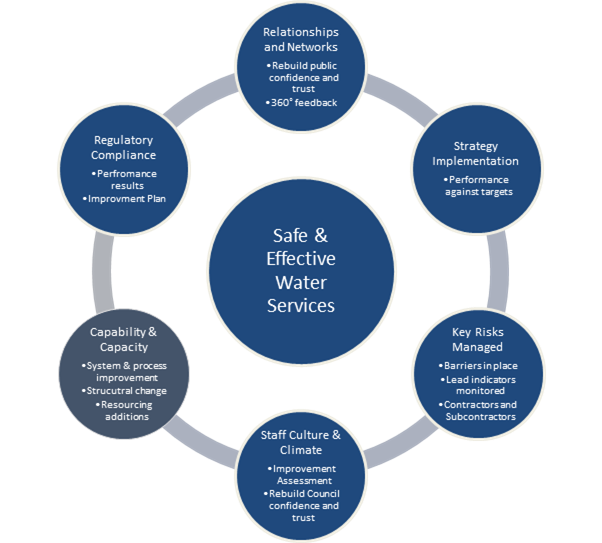
2.7 This
is achieved in a collaborative partnership arrangement with stakeholders and
relevant agencies, working collectively to achieve these objectives.
3.0 CURRENT
SITUATION
3.1 As part of its function, the 3 Waters Improvement Team has oversight
responsibilities to ensure functional linkages and reporting between practical,
operational level risk management measures and the corporate risk management
policy and framework including governance and management oversight mechanisms.
3.2 The Hastings District Council Drinking Water Quality Management Policy
has been reviewed by the 3 Waters Improvement Team who has recommended that it
be put to Council for formal adoption.
4.0 OPTIONS
4.1 The
Council can either adopt the policy as written in Attachment 1, or defer
adoption subject to further amendments that they may consider necessary.
5.0 SIGNIFICANCE
AND ENGAGEMENT
5.1 The Hastings District Council Drinking Water Quality Management Policy
embodies the 6 Principles of Drinking Water Safety which have been recommended
by the Board of Inquiry following their report into the Havelock North
contamination incident.
5.2 The policy reflects the position of the Hastings District Council
and the community’s expectations in regard to safe drinking water and the
statements in Section 3 set out the key areas for achievement.
5.3 Adopting
the policy is considered to be of low significance on the basis that the
commitment to safe drinking water, and the necessary changes and costs, have in
the main already been established and/or implemented.
6.0 ASSESSMENT
OF OPTIONS (INCLUDING FINANCIAL IMPLICATIONS)
6.1 The
development of a policy to document Council’s commitment is seen as an
administrative but necessary component of the WSP that guides Council in meeting
its risk management commitments.
6.2 There
are no financial commitments that result from adopting the policy. The WSP is
the key informing document that establishes the need for risk mitigation and
outlines the extent of those mitigation measures and costs.
6.3 If
the Council believes the policy requires further changes then these can be made
and the policy brought back for adoption at a later time. The timeframes for
completion of the next revision of the WSP will be towards the end of 2019
therefore deferring the policy in the interim is unlikely to put this process
at risk.
7.0 PREFERRED
OPTION/S AND REASONS
7.1 The
recommendation is to adopt the policy as written.
7.2 This
will ensure that Council has demonstrated its commitment to delivering safe
water in a way that underpins the systems, processes and culture that has been
at the forefront of the organisation’s response to the Havelock North
water crisis.
7.3 It
will also ensure that we can meet our legislative obligations in respect of
public health outcomes through the development of comprehensive Water Safety
Plans.
|
8.0 RECOMMENDATIONS
AND REASONS
A) That
the report of the 3 Waters Manager titled “Hastings
District Council Drinking Water Quality Management Policy” dated
11/07/2019 be received.
B) That the Council adopts the Hastings District Council Drinking
Water Policy in Attachment 1 (PMD-02-20-19-4).
With the reasons for this decision
being that the objective of the decision will contribute to meeting the
current and future needs of communities for good quality local infrastructure
and local public services in a way that is most cost-effective for households
and business by:
i) ensuring that the community is provided with drinking water that
is safe, meets all regulatory requirements and is delivered in a way that is
efficient and cost-effective.
|
Attachments:
|
1
|
Drinking Water Quality Management Policy
|
PMD-02-20-19-4
|
|
|
Drinking Water Quality Management
Policy
|
Attachment 1
|
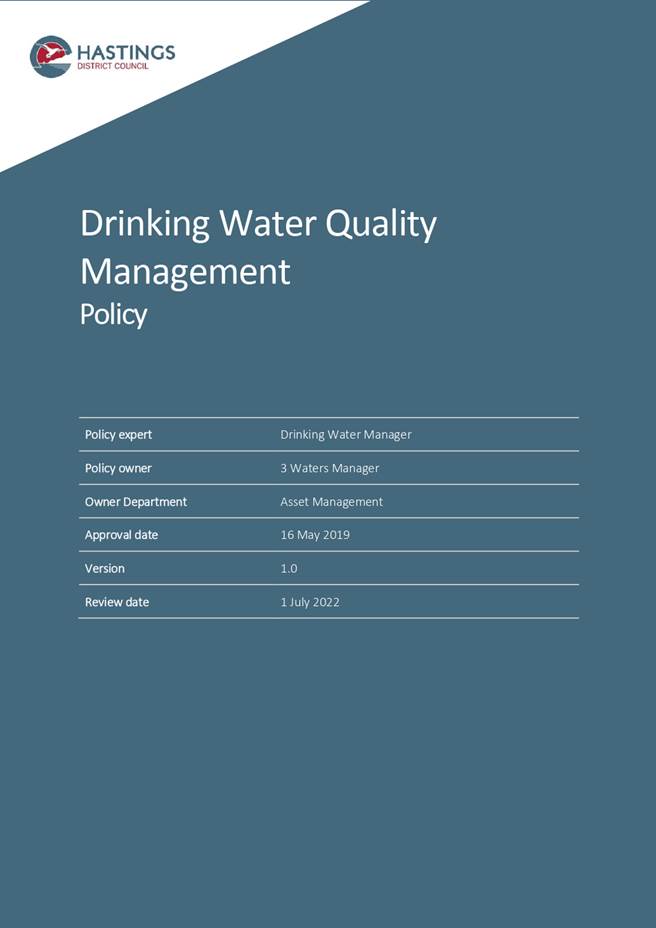
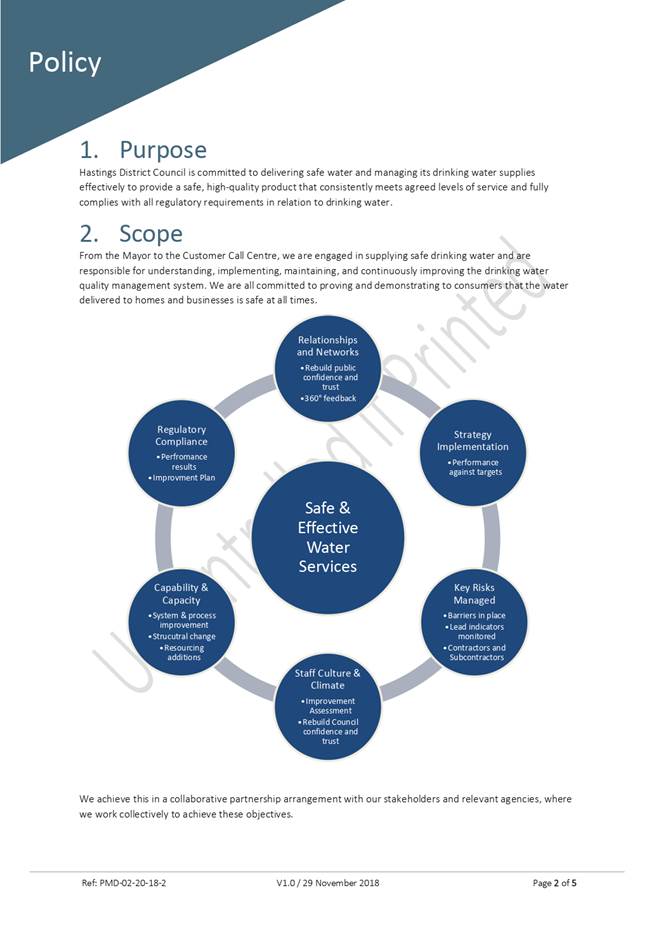
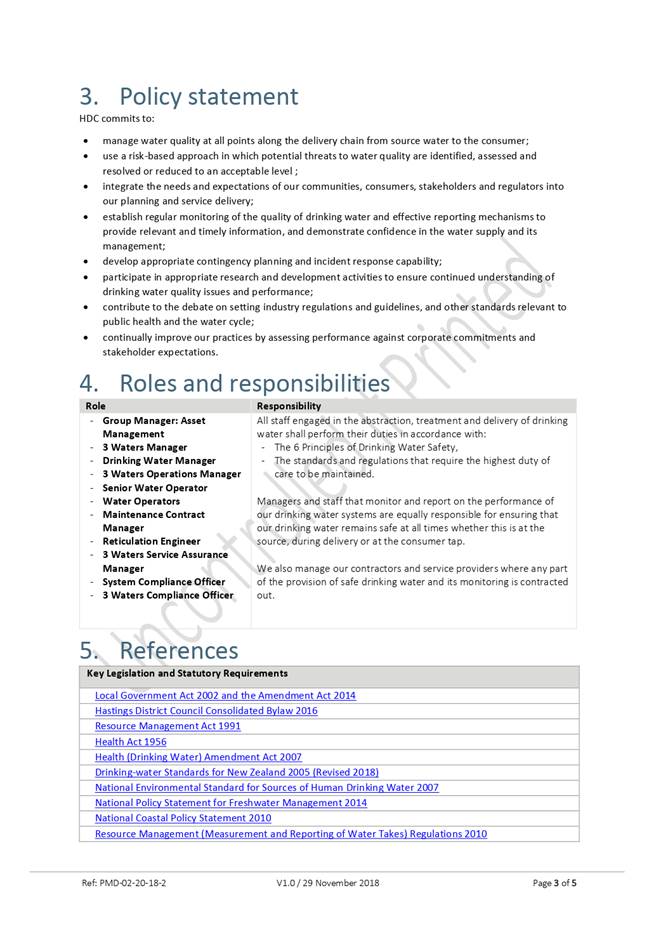
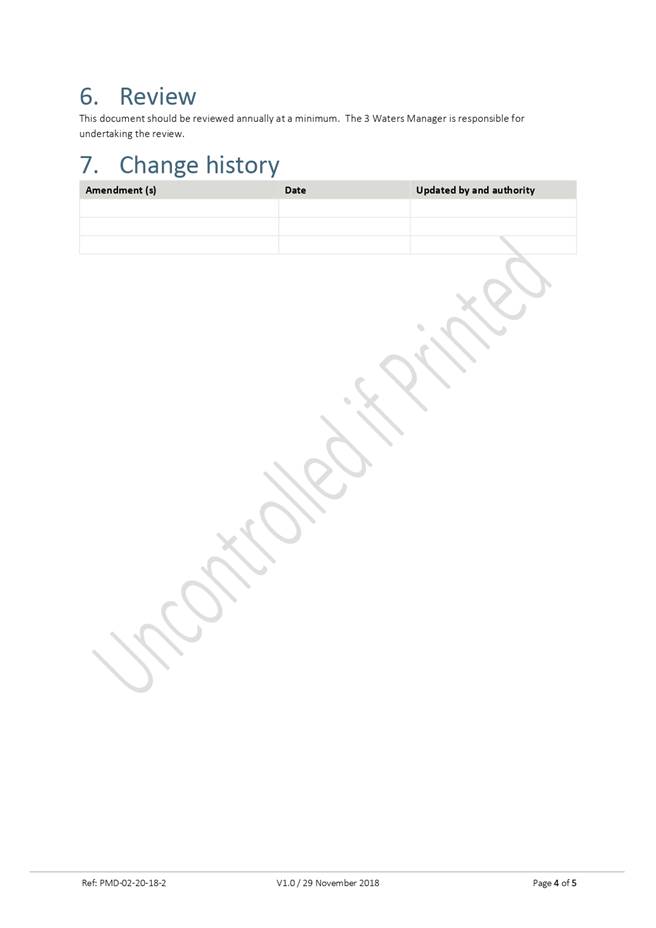

REPORT TO: Council
MEETING DATE: Thursday 11
July 2019
FROM: Environmental Consents Manager
Murray
Arnold
SUBJECT: Notification
of Appointment of Independent Hearings Commissioner
1.0 SUMMARY
1.1 The
purpose of this report is to advise the Council of the appointment of Bill
Wasley (Chair), Paul Cooney, and Louise Wickham (odour expert), independent
Hearing Commissioners, to sit on the joint Hastings District Council - Hawkes
Bay Regional Council hearings panel, to hear and decide on a resource consent
application lodged by The Te Mata Mushroom Company Ltd.
1.2 The
application is for consent to increase production of mushrooms from 25 tonnes
per week to 100 tonnes per week, at 174–176 Brookvale Road, Havelock
North, including:
· increasing compost production up to 500 tonnes per 7-day period;
· extending existing (Phase 1) bunkers and constructing a new building
(adjacent to Phase 2 tunnels);
· constructing a concrete pad in centre of site; and
· retrospective consent for construction of a recycled water/oxidation
pond
1.3 Pursuant
to Section 34A(1) of the Resource Management Act 1991, authority to appoint,
pursuant to Section 100A and 34A(1) of the Act, Hearings Commissioner(s) to
hear and decide an application has been delegated to the Chief Executive, the
Group Manager: Planning and Regulatory Services, the Environmental Consents
Manager, and the Environmental Policy Manager. This delegation is subject
to the requirements that appointed Hearings Commissioners shall hold a valid
certificate of accreditation under section 39A of the Act, and that the
exercise of this authority will be reported to the next available meeting of
Council.
1.4 This
report sets out the reasons for the exercise of delegated authority to appoint
Bill Wasley (Chair), Paul Cooney, and Louise Wickham as independent
commissioners to hear and decide on the application from the Te Mata Mushroom
Company.
2.0 BACKGROUND
2.1 a)
The Te Mata Mushroom Company applied to the Hawkes Bay Regional
Council for resource consent to discharge contaminants in to the air from a
composting and mushroom growing operation, and associated activities, at their
Brookvale Road, Havelock North plant. The application was publicly
notified and a submission was lodged on behalf of the Hastings District
Council. The HDC submission identified that a resource consent would also
be required from the Hastings District Council.
b) The
Te Mata Mushroom Company subsequently applied to the Hastings District Council
for resource consent to increase production of mushrooms from 25 tonnes per
week to 100 tonnes per week at 174 – 176 Brookvale Road, Havelock
North. The application to the HDC was publicly notified and 162
submissions were received, including one lodged on behalf of the Hastings
District Council
c) The
joint hearing is scheduled to be heard by the joint Hearings panel on 31
July–2 August 2019.
d) As
submissions have been lodged on behalf of the Hastings District Council on both
the HBRC and the HDC resource consent applications it is appropriate that the
hearings panel is made up of independent commissioners.
2.2 Bill
Wasley, Paul Cooney and Louise Wickham hold valid certificates of accreditation
under section 39A of the Act and Bill Wasley and Paul Cooney have a Chair
endorsement.
3.0 ASSESSMENT
OF OPTIONS (INCLUDING FINANCIAL IMPLICATIONS)
3.1 This
matter has been delegated to staff who have exercised that delegation and are
advising council of the appointment of Commissioners. This report
completes the requirement set out in the delegation, that Council is informed
of the appointment. Further assessment of options is therefore not
necessary for this report.
4.0 SIGNIFICANCE
AND ENGAGEMENT
4.1 The issue of significance has been considered in terms of
Council’s Significance Policy and in particular the thresholds and
criteria contained within this policy. The decisions required in this report do
not trigger any of the thresholds and are subject to Resource Management Act
1991 submissions and decision making processes.
|
5.0 RECOMMENDATIONS
AND REASONS
A) That
the report of the Environmental Consents Manager titled “Notification
of Appointment of Independent Hearings Commissioner” dated 11/07/2019
be received.
|
Attachments:
There are no
attachments for this report.
REPORT TO: Council
MEETING DATE: Thursday 11
July 2019
FROM: Manager: Democracy and Governance
Services
Jackie
Evans
SUBJECT: Requests
Received under the Local Government Official Information and Meetings Act
(LGOIMA) Monthly Update
1.0 SUMMARY
1.1 The
purpose of this report is to inform the Council of the number of requests under
the local Government official Information Act (LGOIMA) 1987 received in June
2019.
1.2 This
issue arises from the provision of accurate reporting information to enable
effective governance
1.3 The
Council is required to give effect to the purpose of local government as
prescribed by Section 10 of the Local Government Act 2002. That purpose is to
meet the current and future needs of communities for good quality local
infrastructure, local public services, and performance of regulatory functions
in a way that is most cost–effective for households and businesses. Good
quality means infrastructure, services and performance that are efficient and
effective and appropriate to present and anticipated future circumstances.
1.4 The
objective of this decision relevant to the purpose of Local Government is to
ensure that the Council is meeting its legislative obligations.
1.5 This
report concludes by recommending that the report be noted.
2.0 BACKGROUND
2.1 The LGOIMA allows people to request official information held by
local government agencies. It contains rules for how such requests should be
handled, and provides a right to complain to the Ombudsman in certain
situations. The LGOIMA also has provisions governing the conduct of meetings.
Principle of
Availability
2.2 The
principle of availability underpins the whole of the LGOIMA. The Act explicitly
states that:
The question
whether any official information is to be made available … shall be
determined, except where this Act otherwise expressly requires, in accordance
with the purposes of this Act and the principle that the information shall
be made available unless there is good reason for withholding it.
Purpose of the
Act
2.3 The
key purposes of the LGOIMA are to:
· progressively
increase the availability of official information held by agencies, and promote
the open and public transaction of business at meetings, in order to:
o enable more
effective public participation in decision making; and
o promote the
accountability of members and officials; and
o so enhance respect
for the law and promote good local government; and
o protect official
information and the deliberations of local authorities to the extent consistent
with the public interest and the preservation of personal privacy.
2.4 City,
district and regional councils, council controlled organisations and community
boards are subject to LGOIMA and official information means any information
held by an agency subject to the LGOIMA.
2.5 It
is not limited to documentary material, and includes material held in any
format such as:
· written documents, reports, memoranda, letters, notes, emails and
draft documents;
· non-written documentary information, such as material stored on or
generated by computers, including databases, video or tape recordings;
· information which is known to an agency, but which has not yet been
recorded in writing or otherwise (including knowledge of a particular matter
held by an officer, employee or member of an agency in their official
capacity);
· documents and manuals which set out the policies, principles, rules
or guidelines for decision making by an agency;
· the reasons for any decisions that have been made about a person.
2.6 It
does not matter where the information originated, or where it is currently
located, as long as it is held by the agency. For example, the information
could have been created by a third party and sent to the agency. The
information could be held in the memory of an employee of the agency.
What does a
LGOIMA request look like?
2.7 There
is no set way in which a request must be made. A LGOIMA request is made in any
case when a person asks an agency for access to specified official information.
In particular:
· a request can be made in any form and communicated by any means,
including orally;
· the requester does not need to refer to the LGOIMA; and
· the request can be made to any person in the agency.
2.8 The
Council deals with in excess of 14,000 service requests on average each month
from written requests, telephone calls and face to face contact. The LGOIMA
requests dealt with in this report are specific requests for information logged
under formal LGOIMA procedure, which sometimes require collation of information
from different sources and/or an assessment about the release of the
information requested.
Key Timeframes
2.9 An
agency must make a decision and communicate it to the requester ‘as soon
as reasonably practicable’ and no later than 20 working days after
the day on which the request was received.
2.10 The
agency’s primary legal obligation is to notify the requester of the
decision on the request ‘as soon as reasonably practicable’ and
without undue delay. The reference to 20 working days is not the de facto goal
but the maximum unless it is extended appropriately in accordance with the Act.
Failure to comply with time limit may be the subject of a complaint to the
ombudsman.
2.11 The
Act provides for timeframes and extensions as there is a recognition that
organisations have their own work programmes and that official information
requests should not unduly interfere with that programme.
3.0 CURRENT
SITUATION
3.1 Council
has requested that official information requests be notified via a monthly
report.
|
4.0 RECOMMENDATIONS
AND REASONS
A) That the report of the Democratic
Support Manager titled “Requests Received under the Local Government
Official Information and Meetings Act (LGOIMA) Monthly Update” dated
27/06/2019 be received.
B) That
the LGOIMA requests received in June 2019 as set out in Attachment 1
(IRB-2-01-19-1634) of the report in (A) above be noted.
|
Attachments:
|
1
|
Monthly report to Council - June 2019
|
IRB-2-01-19-1634
|
|
|
Monthly report to Council - June 2019
|
Attachment 1
|
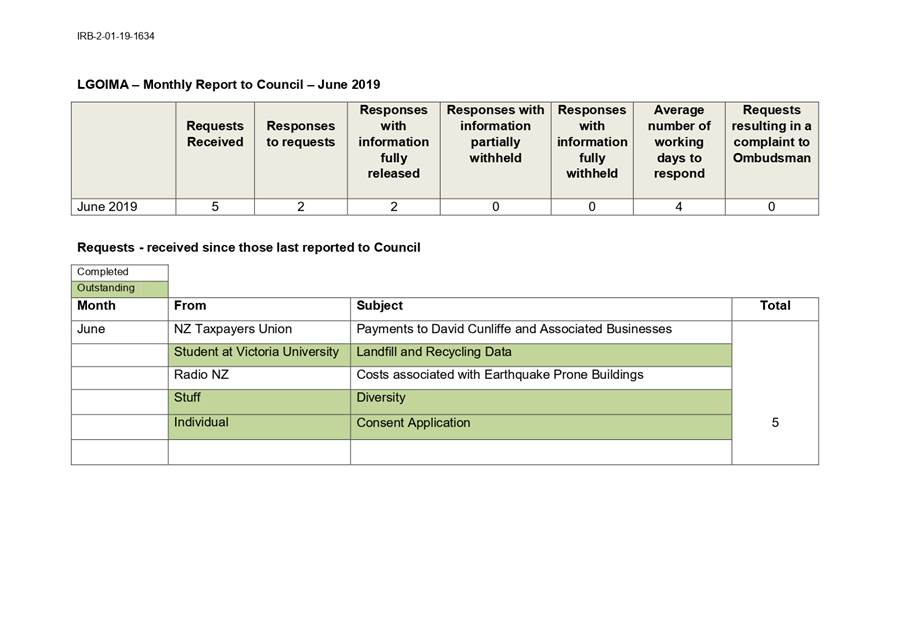
REPORT TO: Council
MEETING DATE: Thursday 11
July 2019
FROM: Principal Advisor: District
Development
Mark
Clews
SUBJECT: Clifton
to Tangoio Coastal Hazards Strategy Joint Committee Minutes
1.0 SUMMARY
1.1 The
purpose of this report is to provide an update on for the Clifton to Tangoio
Coastal Hazard Strategy Joint Committee.
1.2 Attached
are the minutes of the meeting held on 31 May 2019 (Attachment 1)
1.3 As
required by the revised terms of reference endorsed by Council on 20 November
2018, summary notes from that meeting are attached (Attachment 2), and
the Council’s representative on the Technical Advisor Group will be in
attendance to help answer any questions that may arise.
|
2.0 RECOMMENDATIONS
AND REASONS
A) That the
report of the Principal Advisor: District Development titled “Clifton
to Tangoio Coastal Hazards Strategy Joint Committee Minutes”
dated 11/07/2019 be received.
|
Attachments:
|
1
|
Minutes of Joint Committee meeting 31 May 2019
|
STR-14-07-19-600
|
|
|
2
|
Summary notes from 31 May 2019
|
STR-14-07-19-598
|
|
|
Minutes of Joint Committee meeting 31
May 2019
|
Attachment 1
|
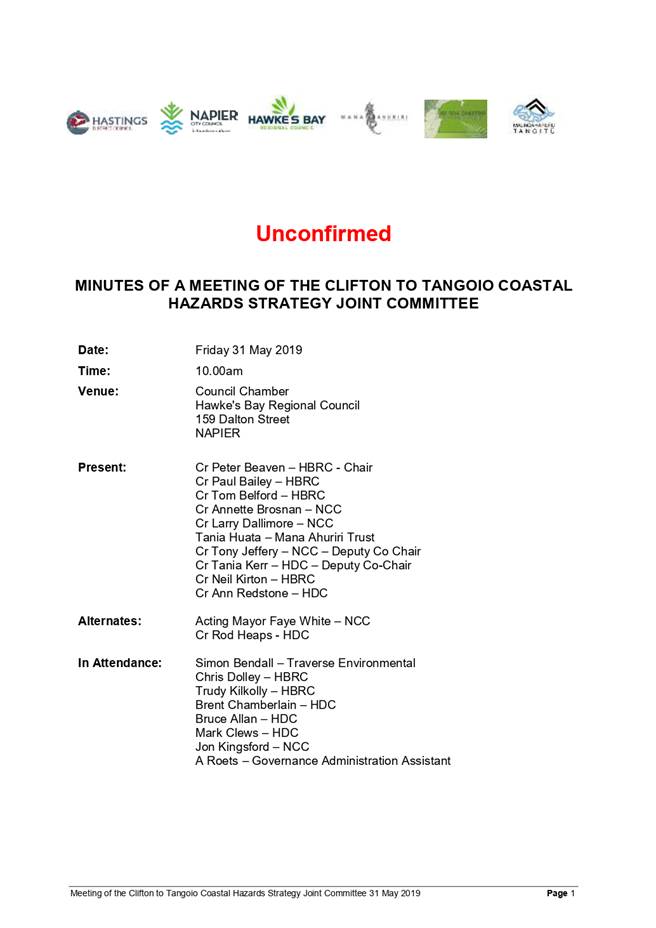
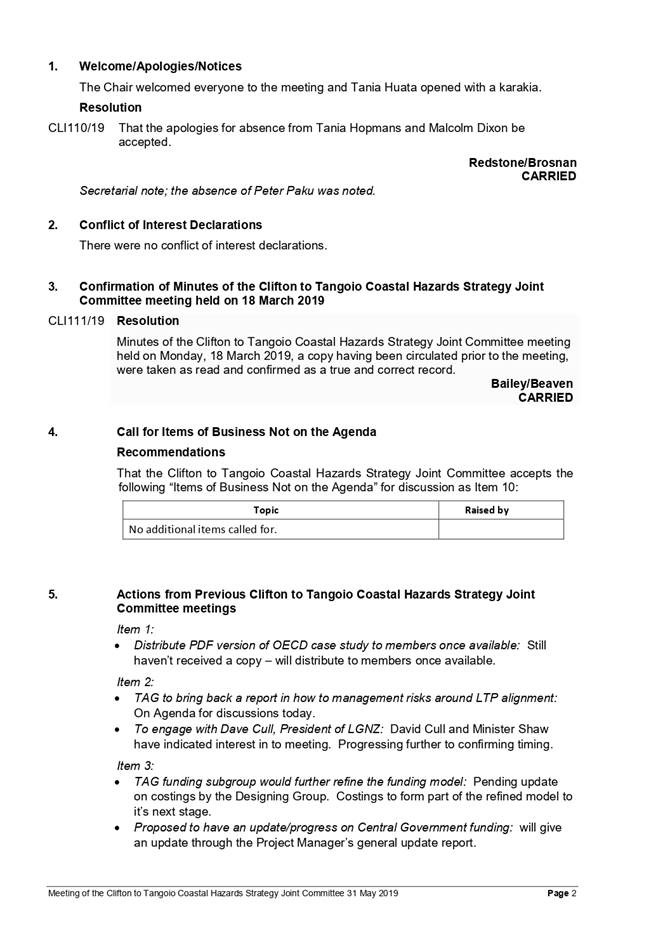
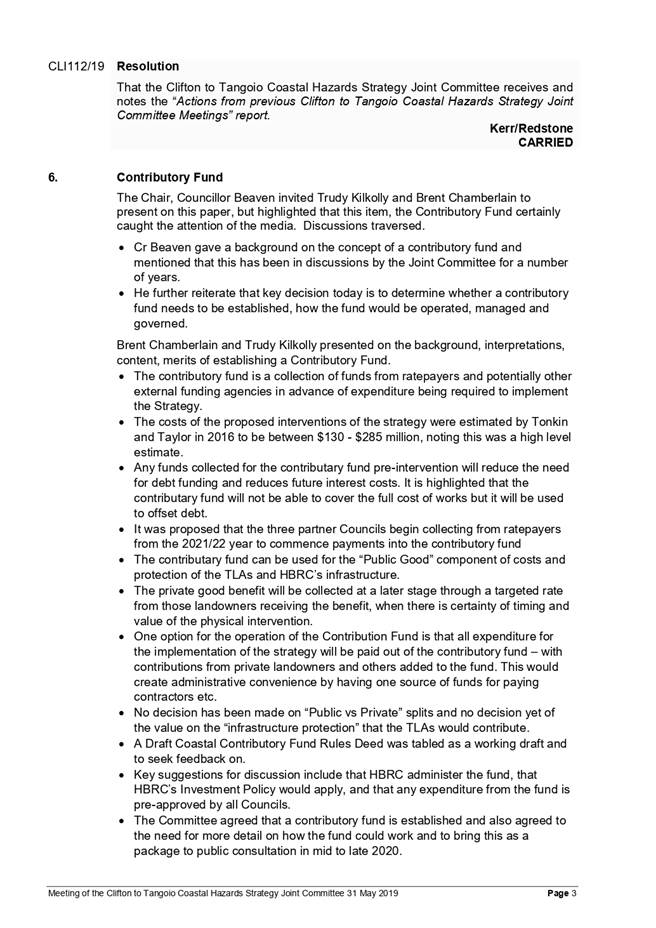
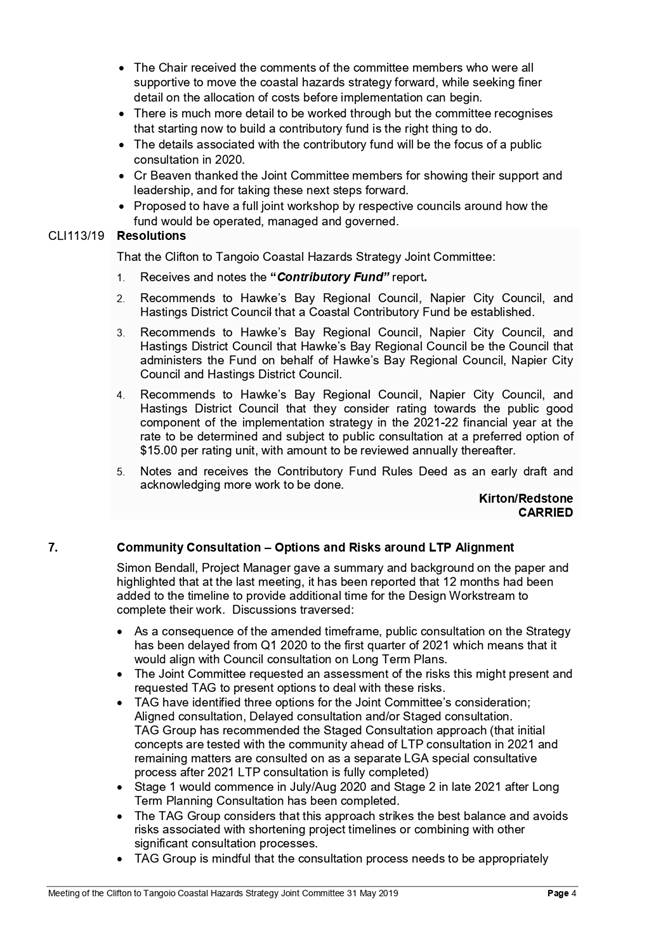
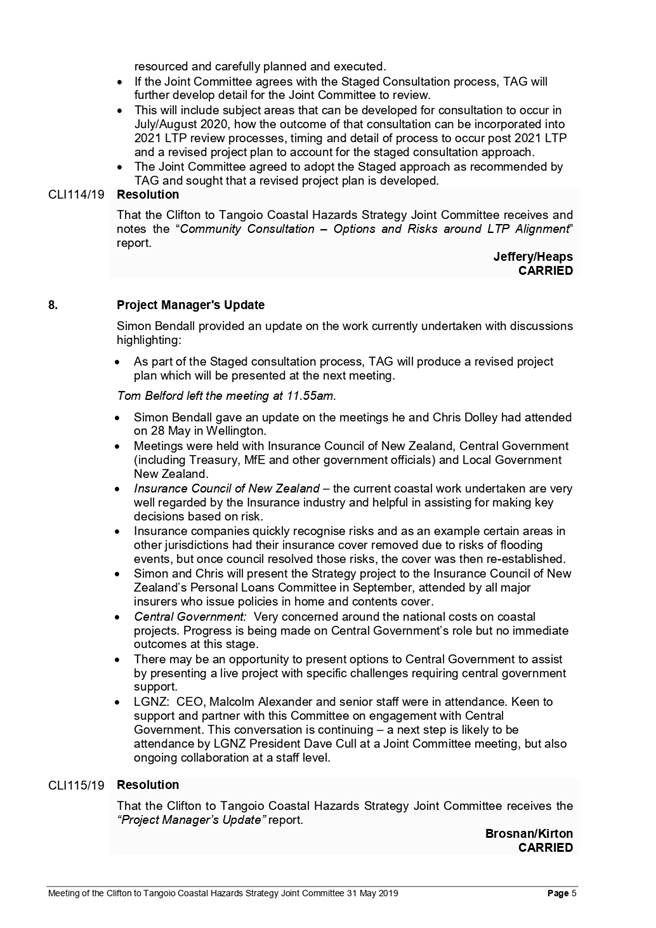
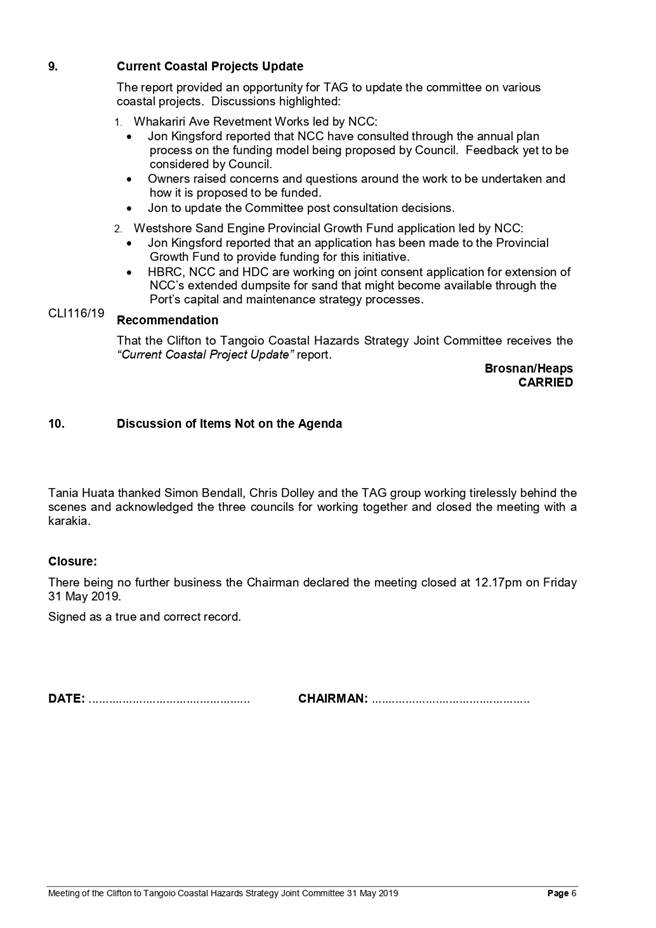
|
Summary notes from 31 May 2019
|
Attachment 2
|
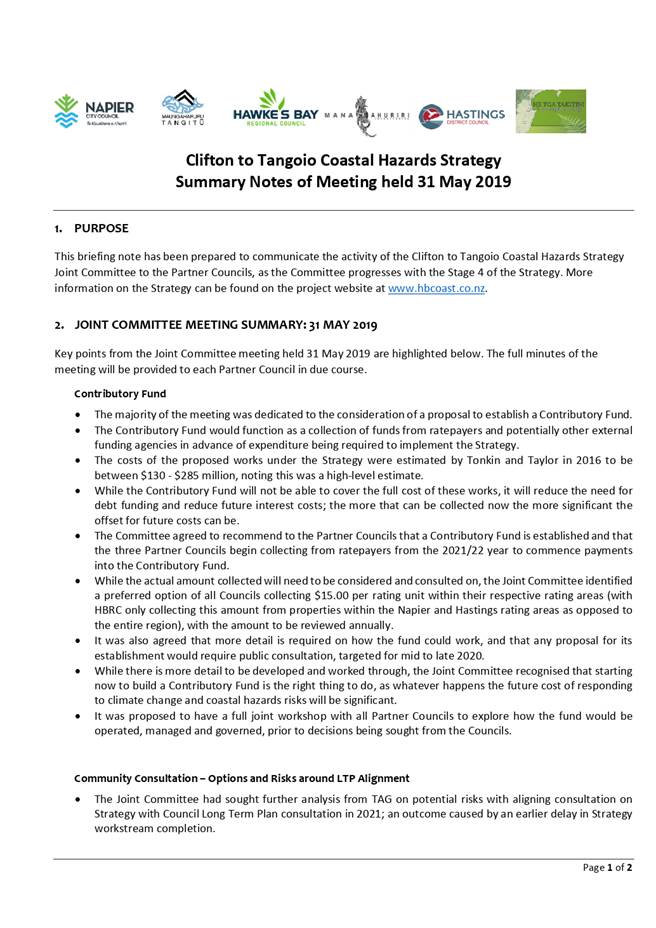
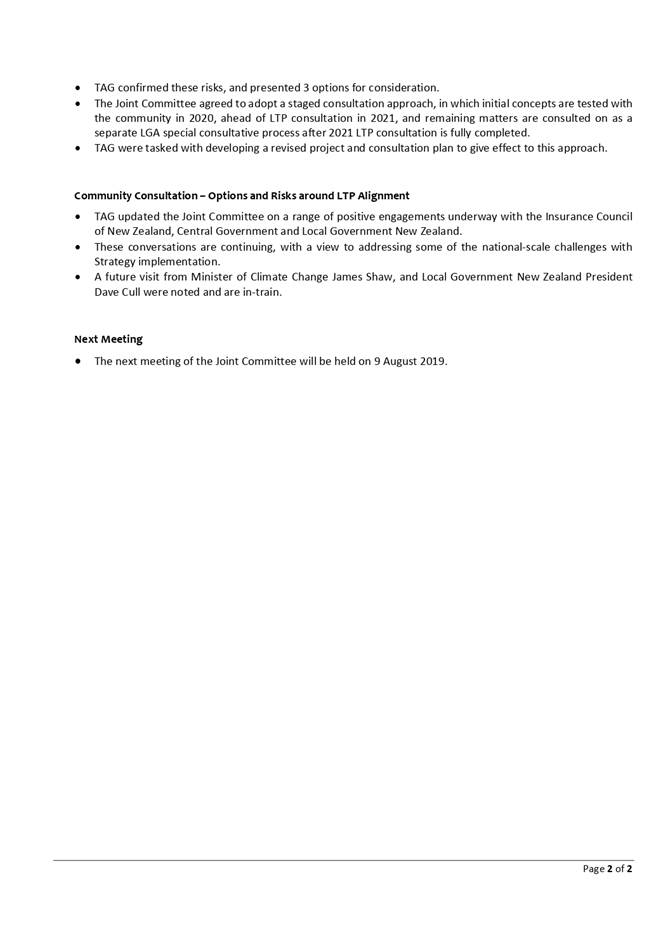
|
TRIM File No. CG-14-1-01379
|
HASTINGS DISTRICT COUNCIL
Council MEETING
Thursday, 11 July 2019
RECOMMENDATION TO EXCLUDE THE PUBLIC
SECTION 48, LOCAL GOVERNMENT OFFICIAL INFORMATION AND
MEETINGS ACT 1987
THAT the public now be excluded from the
following part of the meeting, namely:
18. Hawke's
Bay Museum Trust Regional Collection
The general subject of the matter to be
considered while the public is excluded, the reason for passing this Resolution
in relation to the matter and the specific grounds under Section 48 (1) of the
Local Government Official Information and Meetings Act 1987 for the passing of
this Resolution is as follows:
|
GENERAL SUBJECT OF EACH MATTER TO BE CONSIDERED
|
REASON FOR PASSING THIS RESOLUTION IN RELATION TO
EACH MATTER, AND
PARTICULAR INTERESTS PROTECTED
|
GROUND(S) UNDER SECTION 48(1) FOR THE PASSING OF EACH
RESOLUTION
|
|
|
|
|
|
18. Hawke's
Bay Museum Trust Regional Collection
|
Section 7 (2)
(h)
The withholding
of the information is necessary to enable the local authority to carry out,
without prejudice or disadvantage, commercial activities.
To protect
sensitivities with commercial lease arrangements.
|
Section
48(1)(a)(i)
Where the Local
Authority is named or specified in the First Schedule to this Act under
Section 6 or 7 (except Section 7(2)(f)(i)) of this Act.
|
 Hastings District
Council
Hastings District
Council






























































